Erwin Rommel
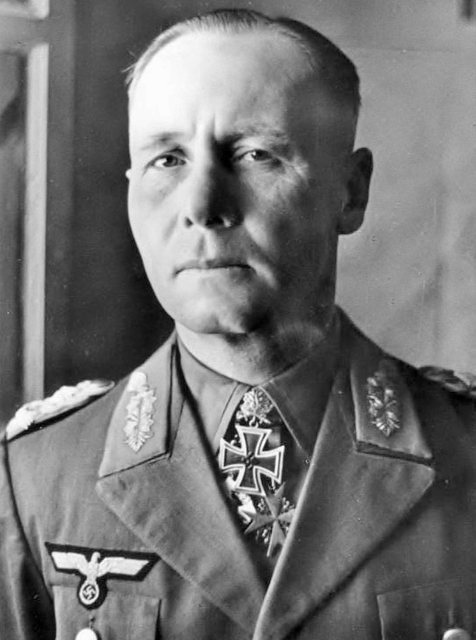
Erwin Rommel

Generalfeldmarschall Erwin Rommel | |
|---|---|
| Birth name | Johannes Erwin Eugen Rommel[41] |
| Nickname(s) | "The Desert Fox" |
| Born | (1891-11-15)15 November 1891 Heidenheim an der Brenz, Kingdom of Württemberg, German Empire |
| Died | 14 October 1944(1944-10-14)(aged 52) Herrlingen, Nazi Germany |
| Buried | Herrlingen cemetery |
| Allegiance |
|
| Service/ | |
| Years of service | 1911–1944 |
| Rank | |
| Commands held |
|
| Battles/wars | See battles World War I
World War II
|
| Awards |
|
| Spouse(s) | Lucia Maria Mollin (m.1916) |
| Children |
|
| Signature | |
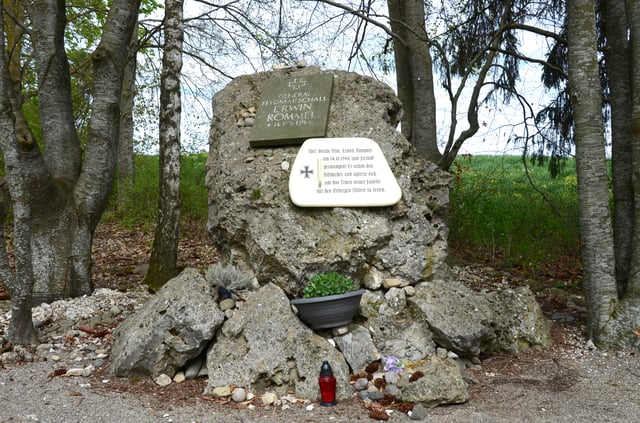
Erwin Rommel Memorial, place of his suicide with a cyanide pill, Herrlingen (2019)
Johannes Erwin Eugen Rommel (15 November 1891 – 14 October 1944) was a German general and military theorist. Popularly known as the Desert Fox, he served as field marshal in the Wehrmacht (Defense Force) of Nazi Germany during World War II, as well as serving in the Reichswehr of the Weimar Republic, and the army of Imperial Germany.
Rommel was a highly decorated officer in World War I and was awarded the Pour le Mérite for his actions on the Italian Front. In 1937 he published his classic book on military tactics, Infantry Attacks, drawing on his experiences from World War I. In World War II, he distinguished himself as the commander of the 7th Panzer Division during the 1940 invasion of France. His leadership of German and Italian forces in the North African campaign established his reputation as one of the most able tank commanders of the war, and earned him the nickname der Wüstenfuchs, "the Desert Fox". Among his British adversaries he earned a strong reputation for chivalry, and the North African campaign has often been called a "war without hate".[42] He later commanded the German forces opposing the Allied cross-channel invasion of Normandy in June 1944.
Rommel supported the Nazi seizure of power and Adolf Hitler, although his reluctant stance towards antisemitism and Nazi ideology and his level of knowledge of the Holocaust remain matters of debate among scholars.[43][44][45][46][47] In 1944, Rommel was implicated in the 20 July plot to assassinate Hitler. Due to Rommel's status as a national hero, Hitler desired to eliminate him quietly instead of immediately executing him, as many other plotters were. Rommel was given a choice between committing suicide, in return for assurances that his reputation would remain intact and that his family would not be persecuted following his death, or facing a trial that would result in his disgrace and execution; he chose the former and committed suicide using a cyanide pill.[48] Rommel was given a state funeral, and it was announced that he had succumbed to his injuries from the strafing of his staff car in Normandy.
Rommel has become a larger-than-life figure in both Allied and Nazi propaganda, and in postwar popular culture, with numerous authors considering him an apolitical, brilliant commander and a victim of the Third Reich although this assessment is contested by other authors as the Rommel myth. Rommel's reputation for conducting a clean war was used in the interest of the West German rearmament and reconciliation between the former enemies – the United Kingdom and the United States on one side and the new Federal Republic of Germany on the other. Several of Rommel's former subordinates, notably his chief of staff Hans Speidel, played key roles in German rearmament and integration into NATO in the postwar era. The German Army's largest military base, the Field Marshal Rommel Barracks, Augustdorf, is named in his honour.
Generalfeldmarschall Erwin Rommel | |
|---|---|
| Birth name | Johannes Erwin Eugen Rommel[41] |
| Nickname(s) | "The Desert Fox" |
| Born | (1891-11-15)15 November 1891 Heidenheim an der Brenz, Kingdom of Württemberg, German Empire |
| Died | 14 October 1944(1944-10-14)(aged 52) Herrlingen, Nazi Germany |
| Buried | Herrlingen cemetery |
| Allegiance |
|
| Service/ | |
| Years of service | 1911–1944 |
| Rank | |
| Commands held |
|
| Battles/wars | See battles World War I
World War II
|
| Awards |
|
| Spouse(s) | Lucia Maria Mollin (m.1916) |
| Children |
|
| Signature | |
Early life and career
Rommel was born on 15 November 1891 in Southern Germany at Heidenheim, 45 kilometres (28 mi) from Ulm, in the Kingdom of Württemberg, then part of the German Empire. He was the third of five children of Erwin Rommel Senior (1860–1913), a teacher and school administrator, and his wife Helene von Lutz, whose father Karl von Luz headed the local government council. As a young man Rommel's father had been a lieutenant in the artillery. Rommel had one older sister, an art teacher who was his favorite sibling, one older brother named Manfred who died in infancy and two younger brothers, of whom one became a successful dentist and the other an opera singer.[49][50][51][52]
At age 18 Rommel joined the local 124th Württemberg Infantry Regiment as a Fähnrich (ensign), in 1910, studying at the Officer Cadet School in Danzig.[53] He graduated in November 1911 and was commissioned as a lieutenant in January 1912 and was assigned to the 124th Infantry in Weingarten.[54] He was posted to Ulm in March 1914 to the 46th Field Artillery Regiment, XIII (Royal Württemberg) Corps, as a battery commander. He returned to the 124th when war was declared.[55] While at Cadet School, Rommel met his future wife, 17-year-old Lucia (Lucie) Maria Mollin (1894–1971), of Polish and Italian descent.[56]
World War I
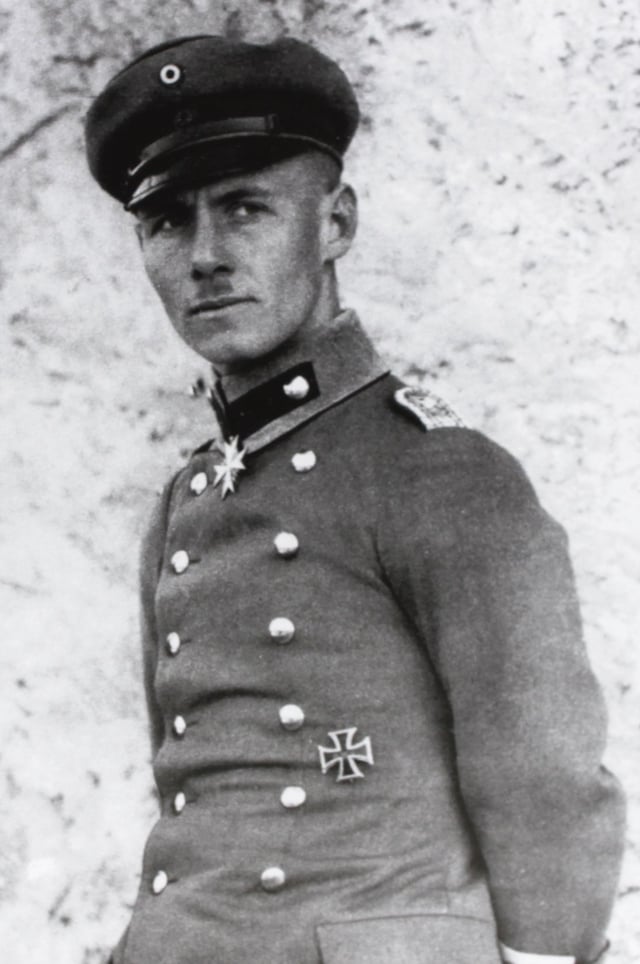
Lieutenant Rommel in Italy, 1917
During World War I, Rommel fought in France as well as in the Romanian (notably at the Second Battle of the Jiu Valley) and Italian campaigns. He successfully employed the tactics of penetrating enemy lines with heavy covering fire coupled with rapid advances, as well as moving forward rapidly to a flanking position to arrive at the rear of hostile positions, to achieve tactical surprise.[57] His first combat experience was on 22 August 1914 as a platoon commander near Verdun, when – catching a French garrison unprepared – Rommel and three men opened fire on them without ordering the rest of his platoon forward.[58] The armies continued to skirmish in open engagements throughout September, as the static trench warfare typical of the First World War was still in the future.[59] For his actions in September 1914 and January 1915, Rommel was awarded the Iron Cross, Second Class.[60] Rommel was promoted to Oberleutnant (first lieutenant) and transferred to the newly created Royal Wurttemberg Mountain Battalion of the Alpenkorps in September 1915, as a company commander.[61] In November 1916 in Danzig, Rommel and Lucia married.[62]
In August 1917, his unit was involved in the battle for Mount Cosna, a heavily fortified objective on the border between Hungary and Romania, which they took after two weeks of difficult uphill fighting.[63] The Mountain Battalion was next assigned to the Isonzo front, in a mountainous area in Italy. The offensive, known as the Battle of Caporetto, began on 24 October 1917.[64] Rommel's battalion, consisting of three rifle companies and a machine gun unit, was part of an attempt to take enemy positions on three mountains: Kolovrat, Matajur, and Stol.[65] In two and a half days, from 25 to 27 October, Rommel and his 150 men captured 81 guns and 9,000 men (including 150 officers), at the loss of six dead and 30 wounded.[66] Rommel achieved this remarkable success by taking advantage of the terrain to outflank the Italian forces, attacking from unexpected directions or behind enemy lines, and taking the initiative to attack when he had orders to the contrary. In one instance, the Italian forces, taken by surprise and believing that their lines had collapsed, surrendered after a brief firefight.[67] In this battle, Rommel helped pioneer infiltration tactics, a new form of maneuver warfare just being adopted by German armies, and later by foreign armies,[68][69] and described by some as Blitzkrieg without tanks.[70][71] He played no role in the early adoption of Blitzkrieg in World War II though.[71] Acting as advance guard in the capture of Longarone on 9 November, Rommel again decided to attack with a much smaller force. Convinced that they were surrounded by an entire German division, the 1st Italian Infantry Division – 10,000 men – surrendered to Rommel. For this and his actions at Matajur, he received the order of Pour le Mérite.[68]
In January 1918, Rommel was promoted to Hauptmann (captain) and assigned to a staff position with XLIV Army Corps, where he served for the remainder of the war.[72]
Between the wars
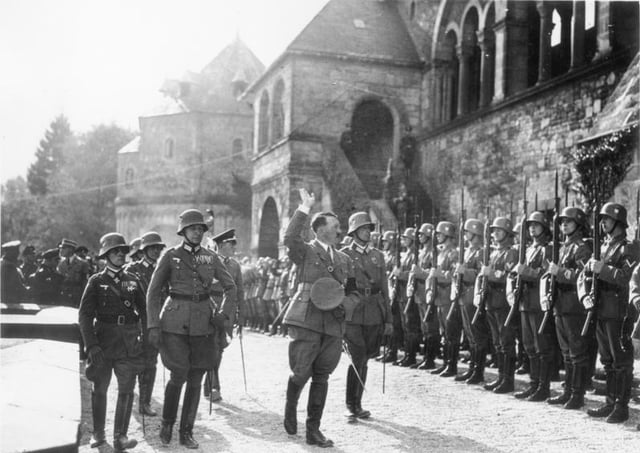
Rommel and Adolf Hitler in Goslar, 1934
Rommel remained with the 124th Regiment until October 1920.[73][66] The regiment was involved in quelling riots and civil disturbances that were occurring throughout Germany at this time.[74] Wherever possible Rommel avoided the use of force in these confrontations.[75] In 1919 he was briefly sent to Friedrichshafen on Lake Constance, where he restored order by "sheer force of personality" in the 32nd Internal Security Company, which was composed of rebellious and pro-communist sailors.[76] He decided against storming the nearby city of Lindau, which had been taken by revolutionary communists.[77] Instead, Rommel negotiated with the city council and managed to return it to the legitimate government through diplomatic means.[44][78] This was followed by his defence of Schwäbisch Gmünd, again bloodless.[79] He was then posted to the Ruhr where a red army was responsible for fomenting unrest. Historian Raffael Scheck praises Rommel as a coolheaded and moderate mind, exceptional amid the many takeovers of revolutionary cities by regular and irregular units and the associated massive violence.[44]
According to Reuth, this period left an indelible impression on Rommel's mind that "Everyone in this Republic was fighting each other," along with direct experience of people attempting to convert Germany into a socialist republic on Soviet lines. There are similarities with Hitler’s experiences: like Rommel, Hitler had known the solidarity of trench warfare and had then participated in the Reichswehr‘s suppression of the First and Second Bavarian Soviet Republics. The need for national unity thus became a decisive legacy of the first World War.[78] Brighton notes that while both believed in the Stab-in-the-back myth, Rommel was able to succeed using peaceful methods because he saw the problem in empty stomachs rather than in Judeo-Bolshevism – which right-wing soldiers such as Hitler blamed for the chaos in Germany.[80]
On 1 October 1920 Rommel was appointed to a company command with the 13th Infantry Regiment in Stuttgart, a post he held for the next nine years.[73][66] He was then assigned as an instructor at the Dresden Infantry School from 1929 to 1933, and during this time was promoted to major, in April 1932.[66][81] While at Dresden, he wrote a manual on infantry training, published in 1934. In October 1933 he was promoted to Oberstleutnant (lieutenant colonel) and given his next command, the 3rd Jäger Battalion, 17th Infantry Regiment, stationed at Goslar.[82] Here he first met Hitler, who inspected his troops on 30 September 1934.[83] In September 1935 Rommel was moved to the War Academy at Potsdam as an instructor, for the next three years.[84] His book Infanterie greift an (Infantry Attacks), a description of his wartime experiences along with his analysis, was published in 1937. It became a bestseller, which, according to Scheck, later "enormously influenced" many armies of the world;[44][85] Adolf Hitler was one of many people who owned a copy.[86]
Hearing of Rommel's reputation as an outstanding military instructor, in February 1937 Hitler assigned him as the War Ministry liaison officer to the Hitler Youth in charge of military training. Here he clashed with Baldur von Schirach, the Hitler Youth leader, over the training that the boys should receive.[87][88][89][90][91] Trying to fulfill a mission assigned to him by the Ministry of War,[92] Rommel had proposed a plan (twice) that would have effectively subordinated Hitler Youth to the army, removing it from NSDAP control. That went against Schirach's express wishes. Schirach appealed directly to Hitler; consequently Rommel was quietly removed from the project in 1938.[93] He had been promoted to Oberst (colonel), on 1 August 1937, and in 1938 he was appointed commandant of the Theresian Military Academy at Wiener Neustadt.[94] In October 1938 Hitler specially requested that Rommel be seconded to command the Führerbegleitbatallion (his escort battalion).[95] This unit accompanied Hitler whenever he traveled outside of Germany.[83] During this period Rommel indulged his interest in engineering and mechanics by learning about the inner workings and maintenance of internal combustion engines and heavy machine guns.[96] He memorized logarithm tables in his spare time and enjoyed skiing and other outdoor sports.[97]
World War II
Poland 1939
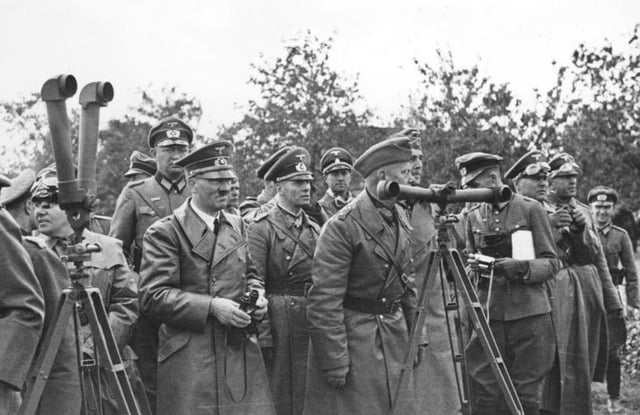
Hitler in Poland (September 1939). Rommel is on his left and Martin Bormann on his right.
Rommel was promoted to Generalmajor on 23 August 1939 and assigned as commander of the Führerbegleitbatallion, tasked with guarding Hitler and his field headquarters during the invasion of Poland, which began on 1 September.[98] According to Remy, Rommel's private letters at this time show that he did not understand Hitler's true nature and intentions, as he quickly went from predicting a swift peaceful settlement of tensions to approving Hitler's reaction ("bombs will be retaliated with bombs") to the Gleiwitz incident (a false flag operation staged by Hitler and used as a pretext for the invasion).[99] Hitler took a personal interest in the campaign, often moving close to the front in the Führersonderzug (headquarters train).[100] Rommel attended Hitler's daily war briefings and accompanied him everywhere, making use of the opportunity to observe first-hand the use of tanks and other motorized units.[101] On 26 September Rommel returned to Berlin to set up a new headquarters for his unit in the Reich Chancellery.[102] Rommel returned briefly to Warsaw on 5 October to prepare for the German victory parade.[103] He described the devastated Warsaw in a letter to his wife, concluding with: "There has been no water, no power, no gas, no food for two days. They have erected numerous barricades which blocked civilian movement and exposed people to bombardments from which they could not escape. The mayor estimated the number of the dead and injured to be 40,000 ... The inhabitants probably drew a breath of relief that we have arrived and rescued them".[104][105]
France 1940
Panzer Division commander
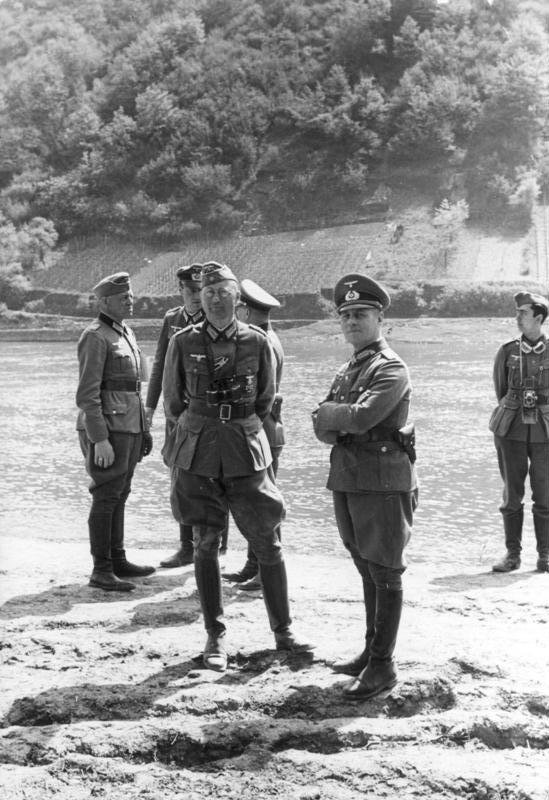
General Erwin Rommel and his staff observe troops of the 7th Panzer Division practicing a river crossing at the Moselle River in France in 1940.
Following the campaign in Poland, Rommel began lobbying for command of one of Germany's panzer divisions, of which there were then only ten.[106] Rommel's successes in World War I were based on surprise and maneuver, two elements for which the new panzer units were ideally suited.[107] Rommel received a promotion to a general's rank from Hitler ahead of more senior officers. Rommel obtained the command he aspired to, despite having been earlier turned down by the army's personnel office, which had offered him command of a mountain division instead.[108] According to Caddick-Adams, he was backed by Hitler, the influential Fourteenth Army commander Wilhelm List (a fellow Württemberger middle-class "military outsider") and likely Guderian as well.[109]
Going against military protocol, this promotion added to Rommel's growing reputation as one of Hitler's favoured commanders,[110] although his later outstanding leadership in France quelled complaints about his self-promotion and political scheming.[111] The 7th Panzer Division had recently been converted to an armoured division consisting of 218 tanks in three battalions (thus, one tank regiment, instead of the two assigned to a standard panzer division),[112] with two rifle regiments, a motorcycle battalion, an engineer battalion, and an anti-tank battalion.[113] Upon taking command on 10 February 1940, Rommel quickly set his unit to practicing the maneuvers they would need in the upcoming campaign.[114]
Invasion of the Netherlands, Belgium and France
The invasion began on 10 May 1940. By the third day Rommel and the advance elements of his division, together with a detachment of the 5th Panzer Division under Colonel Hermann Werner, had reached the River Meuse, where they found the bridges had already been destroyed (Guderian and Reinhardt reached the river on the same day).[115][116] Rommel was active in the forward areas, directing the efforts to make a crossing, which were initially unsuccessful due to suppressive fire by the French on the other side of the river. Rommel brought up tanks and flak units to provide counter-fire and had nearby houses set on fire to create a smokescreen. He sent infantry across in rubber boats, appropriated the bridging tackle of the 5th Panzer Division, personally grabbed a light machine gun to fight off a French counterattack supported by tanks, and went into the water himself, encouraging the sappers and helping lash together the pontoons.[117][118] By 16 May Rommel reached Avesnes, and contravening all orders and doctrine, he pressed on to Cateau.[119] That night, the French II Army Corps was shattered and on 17 May, Rommel's forces took 10,000 prisoners, losing 36 men in the process. He was surprised to find out only his vanguard had followed his tempestuous surge. The High Command and Hitler had been extremely nervous about his disappearance, although they awarded him the Knight's Cross. Rommel's (and Guderian's) successes and the new possibilities offered by the new tank arm were welcomed by a small number of generals, but worried and paralysed the rest.[120]
Battle of Arras
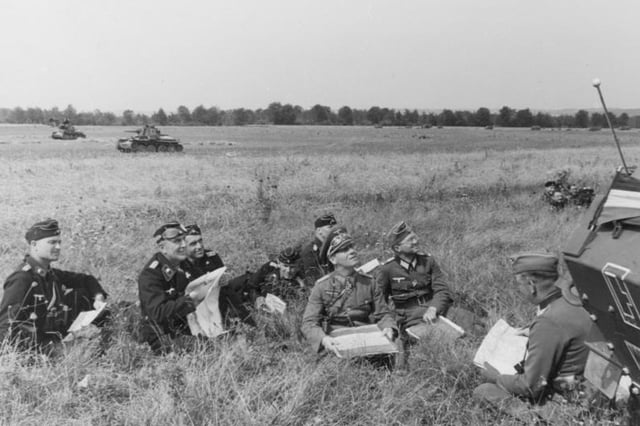
Rommel and staff during the Battle for France, June 1940
On 20 May Rommel reached Arras.[121] General Hermann Hoth received orders that the town should be bypassed and its British garrison thus isolated. He ordered the 5th Panzer Division to move to the west and 7th Panzer Division to the east, flanked by the SS Division Totenkopf.[122] The following day the British launched a counterattack, meeting the SS Totenkopf with two infantry battalions supported by heavily armoured Matilda Mk I and Matilda II tanks in the Battle of Arras. The German 37 mm anti-tank gun proved ineffective against the heavily armoured Matildas. The 25th Panzer Regiment and a battery of 88 mm (3.5 in) anti-aircraft guns were called in to support, and the British withdrew.[123]
On 24 May, Field Marshal von Rundstedt and Field Marshal von Kluge issued a halt order, which Hitler approved.[124] The reason for this decision is still a matter of debate.[125][126][127] The halt order was lifted on 26 May.[126] 7th Panzer continued its advance, reaching Lille on 27 May. For the assault, Hoth placed the 5th Panzer Division's Panzer Brigade under Rommel's command.[128] The Siege of Lille continued until 31 May, when the French garrison of 40,000 men surrendered. 7th Panzer was given six days leave, during which Rommel was summoned to Berlin to meet with Hitler. He was the only divisional commander present at the planning session for Fall Rot (Case Red), the second phase of the invasion of France. By this time the evacuation of the BEF was complete; over 338,000 Allied troops had been evacuated across the Channel, though they had to leave behind all their heavy equipment and vehicles.[129]
Drive for the Channel
Rommel, resuming his advance on 5 June, drove for the River Seine to secure the bridges near Rouen. Advancing 100 kilometres (62 mi) in two days, the division reached Rouen to find the bridges destroyed. On 10 June, Rommel reached the coast near Dieppe, sending Hoth the laconic message "Bin an der Küste" or "Am on the coast".[130] On 17 June, 7th Panzer was ordered to advance on Cherbourg, where additional British evacuations were underway. The division advanced 240 kilometres (150 mi) in 24 hours, and after two days of shelling, the French garrison surrendered on 19 June.[131] The speed and surprise it was consistently able to achieve, to the point where both the enemy and the Oberkommando des Heeres (OKH; German High Command) at times lost track of its whereabouts, earned the 7th Panzers the nickname Gespensterdivision (Ghost Division).[132]
After the armistice with the French was signed on 22 June, the division was placed in reserve, being sent first to the Somme and then to Bordeaux to re-equip and prepare for Unternehmen Seelöwe (Operation Sea Lion), the planned invasion of Britain.[133] This invasion was later cancelled as Germany was not able to acquire the air superiority needed for a successful outcome, while the Kriegsmarine was massively outnumbered by the Royal Navy.[134]
Execution of prisoners in France
In France, Rommel ordered the execution of one French officer who refused three times to cooperate when being taken prisoner; there are disputes as to whether this execution was justified.[135][136] Bewley remarks that the shooting of a prisoner who does not behave as a prisoner is a legal option; however, this act was brutal because the officer did not have a gun, while Richard Weston, veteran at Tobruk, argues that it was not only legal but also made sense considering Rommel's situation.[137][138] Caddick-Adams comments that this would make Rommel a war criminal condemned by his own hand, and that other authors overlook this episode.[139] French historian Petitfrère remarks that Rommel was in a hurry and had no time for useless palavers, although this act was still debatable.[140] Telp remarks that, "For all his craftiness, Rommel was chivalrous by nature and not prone to order or condone acts of needless violence ... He treated prisoners of war with consideration. On one occasion, he was forced to order the shooting of a French lieutenant-colonel for refusing to obey his captors."[141] Scheck says, "Although there is no evidence incriminating Rommel himself, his unit did fight in areas where German massacres of black French prisoners of war were extremely common in June 1940."[142][143][144][145]
According to some authors, during the fighting in France, Rommel's 7th Panzer Division, alongside troops from 5th Panzer Division, committed numerous atrocities against French troops including the murder of 50 surrendering officers and men at Quesnoy and the nearby Airaines[1][2][148][149] After the war a memorial was erected to the commanding French officer Charles N'Tchoréré allegedly executed by soldiers under Rommel's command. The division is considered by Scheck to have been "likely" responsible for the execution of POWs in Hangest-sur-Somme,[3] while Scheck believes they were too far away to have been involved in the massacres at Airaines and nearby villages. French historian Dominique Lormier states the number of victims of 7th Panzer Division in Airaines at 109 mostly French-African soldiers from Senegal.[151] Historian Daniel Butler agrees that it was possible the massacre at Le Quesnoy happened given the existence of Nazis like Hanke in Rommel's division, while stating that in comparison with other German units, few sources regarding such actions of the men of the 7th Panzer exist (Butler believes that "it's almost impossible to imagine" Rommel authorizing or countenancing such actions, in either case[152]). Showalter claims there was no massacre at Le Quesnoy.[153] Claus Telp comments that Airaines was not in the sector of the 7th, but at Hangest and Martainville elements of the 7th might have shot some prisoners and used British Colonel Broomhall as a human shield (although Telp is of the opinion that it was unlikely Rommel approved or even knew about these two incidents).[154]
North Africa 1941–1943

Western Desert battle area
On 6 February 1941, Rommel was appointed commander of the new Deutsches Afrika Korps (DAK), consisting of the 5th Light Division (later renamed 21st Panzer Division) and of the 15th Panzer Division.[155] He was promoted to Generalleutnant three days later and flew to Tripoli on 12 February.[156] The DAK had been sent to Libya in Operation Sonnenblume, to support Italian troops that had been severely defeated by British Commonwealth forces in Operation Compass.[156] His efforts in the Western Desert Campaign earned Rommel the nickname the "Desert Fox" from British journalists.[157] Allied troops in Africa were commanded by General Archibald Wavell, Commander-in-Chief Middle East Command.[158]
First Axis offensive
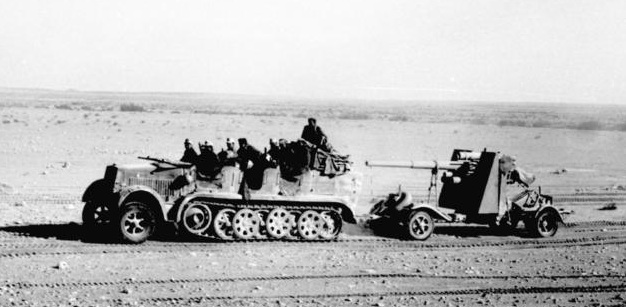
Sd.Kfz. 6/1 with 88mm gun in tow, April 1941
Rommel and his troops were technically subordinate to Italian commander-in-chief General Italo Gariboldi.[155] Disagreeing with the Oberkommando der Wehrmacht (OKW, German armed forces high command) orders to assume a defensive posture along the front line at Sirte, Rommel resorted to subterfuge and insubordination to take the war to the British.[159] According to Remy, the General Staff tried to slow him down but Hitler encouraged him to advance—an expression of the conflict which had existed between Hitler and the army leadership since the invasion of Poland.[160] He decided to launch a limited offensive on 24 March with the 5th Light Division, supported by two Italian divisions.[161] This thrust was not anticipated by the British, who had Ultra intelligence showing that Rommel had orders to remain on the defensive until at least May, when the 15th Panzer Division were due to arrive.[162]
The British Western Desert Force had meanwhile been weakened by the transfer in mid-February of three divisions for the Battle of Greece.[163] They fell back to Mersa El Brega and started constructing defensive works.[164] Rommel continued his attack against these positions to prevent the British from building up their fortifications. After a day of fierce fighting on 31 March, the Germans captured Mersa El Brega.[165] Splitting his force into three groups, Rommel resumed the advance on 3 April. Benghazi fell that night as the British pulled out of the city.[166][167] Gariboldi, who had ordered Rommel to stay in Mersa El Brega, was furious. Rommel was equally forceful in his response, telling Gariboldi, "One cannot permit unique opportunities to slip by for the sake of trifles".[168] A signal arrived from General Franz Halder reminding Rommel that he was to halt in Mersa El Brega. Knowing Gariboldi could not speak German, Rommel told him the message gave him complete freedom of action. Gariboldi backed down.[169]
On 4 April, Rommel was advised by his supply officers that fuel was running short, which could result in a delay of up to four days. The problem was Rommel's fault, as he had not advised his supply officers of his intentions, and no fuel dumps had been set up. Rommel ordered the 5th Light Division to unload all their lorries and return to El Agheila to collect fuel and ammunition. Driving through the night, they were able to reduce the halt to a single day. Fuel supply was problematic throughout the campaign, as no petrol was available locally; it had to be brought from Europe by tanker and then carried by road to where it was needed.[170][171] Food and fresh water were also in short supply and it was difficult to move tanks and other equipment off-road through the sand.[172] Cyrenaica was captured by 8 April, except for the port city of Tobruk, which was besieged on 11 April.[173][174]
Siege of Tobruk

Afrika Korps Panzer III advances past a vehicle burning in the desert, April 1941

Map of Halfaya Pass and surrounding area
The siege of Tobruk was not technically a siege, as the defenders were still able to move supplies and reinforcements into the city via the port.[175] Rommel knew that by capturing the port he could greatly reduce the length of his supply lines and increase his overall port capacity, which was insufficient even for day-to-day operations and only half that needed for offensive operations.[176] The city, which had been heavily fortified by the Italians during their 30-year occupation, was garrisoned by the 18th Infantry Brigade of the Australian 7th Division, the Australian 9th Division, HQ 3rd Armoured Brigade, several thousand British infantrymen, and one regiment of Indian infantry, for a total of 36,000 men.[177] The commanding officer was Australian Lieutenant General Leslie Morshead.[178] Hoping to catch the defenders off-guard, Rommel launched a failed attack on 14 April.[179]
Rommel requested reinforcements, but the OKW, then completing preparations for Operation Barbarossa, refused.[180] General Friedrich Paulus, head of the Operations Branch of OKH, arrived on 25 April to review the situation.[181] He was present for a second failed attack on the city on 30 April. On 4 May Paulus ordered that no further attempts should be made to take Tobruk via a direct assault. This order was not open to interpretation, and Rommel had no choice but to comply.[182] Aware of this order from intelligence reports, Churchill urged Wavell to seize the initiative. While awaiting further reinforcements and a shipment of 300 tanks that were already on their way, Wavell launched a limited offensive code named Operation Brevity on 15 May. The British briefly seized Sollum, Fort Capuzzo, and the important Halfaya Pass, a bottleneck along the coast near the border between Libya and Egypt. Rommel soon forced them to withdraw.[183][184] On 15 June Wavell launched Operation Battleaxe. The attack was defeated in a four-day battle at Sollum and Halfaya Pass, resulting in the loss of 98 British tanks. The Germans lost 12 tanks, while capturing and seriously damaging over 20 British tanks.[185] The defeat resulted in Churchill replacing Wavell with General Claude Auchinleck as theatre commander.[186] Rommel appointed Heinrich Kirchheim as commander of 5th Light Division on 16 May, became displeased and replaced him with Johann von Ravenstein on 30 May 1941.[187][188]
In August, Rommel was appointed commander of the newly created Panzer Group Africa, with Fritz Bayerlein as his chief of staff.[189] The Afrika Korps, comprising the 15th Panzer Division and the 5th Light Division, now reinforced and redesignated 21st Panzer Division, was put under command of Generalleutnant Ludwig Crüwell. In addition to the Afrika Korps, Rommel's Panzer Group had the 90th Light Division and four Italian divisions, three infantry divisions investing Tobruk, and one holding Bardia. The two Italian armoured divisions, Ariete and Trieste, were still under Italian control. They formed the Italian XX Motorized Corps under the command of General Gastone Gambara.[190] Two months later Hitler decided he must have German officers in better control of the Mediterranean theatre, and appointed Field Marshal Albert Kesselring as Commander in Chief, South. Kesselring was ordered to get control of the air and sea between Africa and Italy.[190]
Operation Crusader
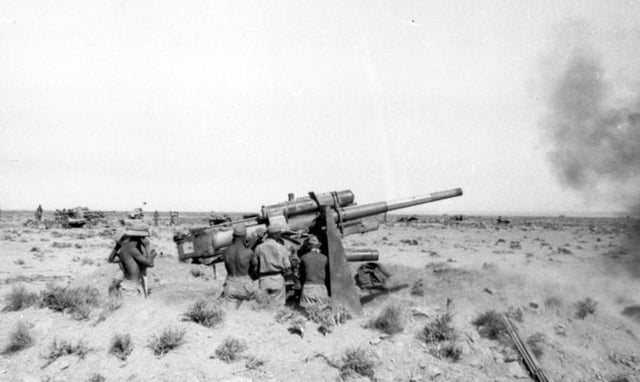
8.8 cm (3 in) Flak 18 guns fire upon British armour

Rommel conversing with his staff near El Agheila, 12 January 1942
Following his success in Battleaxe, Rommel returned his attention to the capture of Tobruk. He made preparations for a new offensive, to be launched between 15 and 20 November.[191] Meanwhile, Auchinleck reorganised Allied forces and strengthened them to two corps, XXX and XIII, which formed the British Eighth Army, which was placed under the command of Alan Cunningham. Auchinleck had 770 tanks and double the number of Axis aircraft.[192] Rommel opposed him with the 15th and 21st Panzer Divisions with a total of 260 tanks, the 90th Light Infantry division, five Italian infantry divisions, and one Italian armoured division of 278 tanks.[193][194]
Auchinleck launched Operation Crusader, a major offensive to relieve Tobruk, on 18 November 1941. The XIII Corps on the right were assigned to attack Sidi Omar, Capuzzo, Sollum, and Bardia; the XXX Corps (which included most of the armour) were to move on the left southern flank to a position about 30 miles (48 km) south of Tobruk, with the expectation that Rommel would find this move so threatening that he would move his armour there in response. Once Rommel's tanks were written down, the British 70th Infantry Division would break out of Tobruk to link up with XXX Corps.[195][196] Rommel reluctantly decided on 20 November to call off his planned attack on Tobruk.[197]
Some elements of the 7th Armoured Division were stopped on 19 January by the Italian Ariete Armoured Division at Bir el Gobi, but they also managed to capture the airfields at Sidi Rezegh, 10 miles (16 km) from Tobruk.[198] Engaging the Allied tanks located there became Rommel's primary objective. Noting that the British armour was separated into three groups incapable of mutual support, he concentrated his Panzers so as to gain local superiority.[199] The expected breakout from Tobruk, which took place on 20 November, was stopped by the Italians. The airfield at Sidi Rezegh was retaken by 21st Panzer on 22 November. In four days of fighting, the Eighth Army lost 530 tanks and Rommel only 100.[200] The German forces near Halfaya Pass were cut off on 23 November.[200]
Wanting to exploit the British halt and their apparent disorganisation, on 24 November Rommel counterattacked near the Egyptian border in an operation that became known as the "dash to the wire". Unknown to Rommel, his troops passed within 6 kilometres (4 mi) of a major British supply dump. Cunningham asked Auchinleck for permission to withdraw into Egypt, but Auchinleck refused, and soon replaced Cunningham as commander of Eighth Army with Major General Neil Ritchie.[201][202] The German counterattack stalled as it outran its supplies and met stiffening resistance, and was criticised by the German High Command and some of Rommel's staff officers.[203]
While Rommel drove into Egypt, the remaining Commonwealth forces east of Tobruk threatened the weak Axis lines there. Unable to reach Rommel for several days,[4] Rommel's Chief of Staff, Siegfried Westphal, ordered the 21st Panzer Division withdrawn to support the siege of Tobruk. On 27 November the British attack on Tobruk linked up with the defenders, and Rommel, having suffered losses that could not easily be replaced, had to concentrate on regrouping the divisions that had attacked into Egypt. By 7 December Rommel fell back to a defensive line at Gazala, just west of Tobruk, all the while under heavy attack from the Desert Air Force. The Bardia garrison surrendered on 2 January and Halfaya on 17 January 1942.[205] The Allies kept up the pressure, and Rommel was forced to retreat all the way back to the starting positions he had held in March, reaching El Agheila in December 1941.[206] The British had retaken almost all of Cyrenaica, but Rommel's retreat dramatically shortened his supply lines.[207]
Battle of Gazala and capture of Tobruk
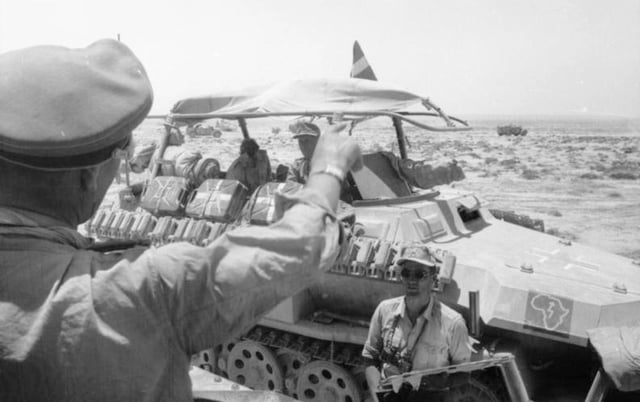
North Africa, Rommel in a Sd.Kfz. 250/3
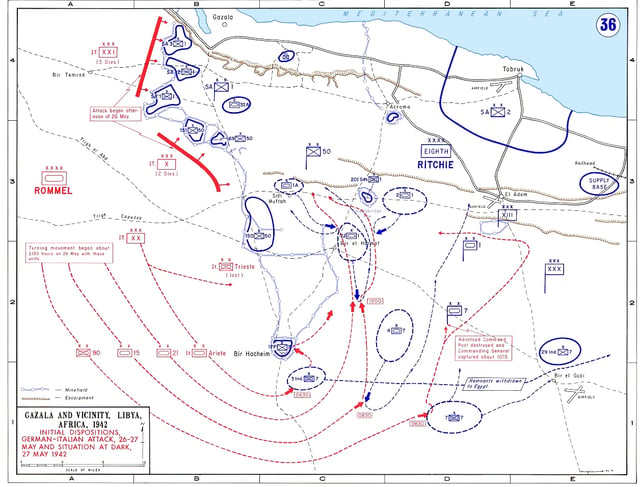
Situation in "the Cauldron", 27 May 1942

The Afrika Korps enters Tobruk.
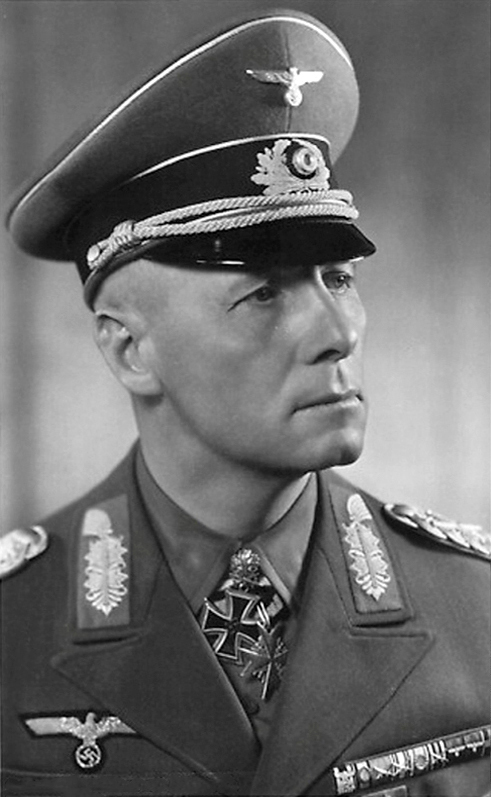
Rommel in 1942
On 5 January 1942 the Afrika Korps received 55 tanks and new supplies and Rommel started planning a counterattack. On 21 January, Rommel launched the attack.[208][209] Caught by surprise by the Afrika Korps, the Allies lost over 110 tanks and other heavy equipment. The Axis forces retook Benghazi on 29 January and Timimi on 3 February, with the Allies pulling back to a defensive line just before the Tobruk area south of the coastal town of Gazala. Rommel placed a thin screen of mobile forces before them, and held the main force of the Panzerarmee well back near Antela and Mersa Brega.[210] Between December 1941 and June 1942, Rommel had excellent information about the disposition and intentions of the Commonwealth forces. Bonner Fellers, the US diplomat in Egypt, was sending detailed reports to the US State Department using a compromised code.[211]
Following Kesselring's successes in creating local air superiority around the British naval and air bases at Malta in April 1942, an increased flow of supplies reached the Axis forces in Africa.[212] With his forces strengthened, Rommel contemplated a major offensive operation for the end of May. He knew the British were planning offensive operations as well, and he hoped to pre-empt them. While out on reconnaissance on 6 April, he was severely bruised in the abdomen when his vehicle was the target of artillery fire.[213] The British had 900 tanks in the area, 200 of which were new Grant tanks. Unlike the British, the Axis forces had no armoured reserve; all operable equipment was put into immediate service. Rommel's Panzer Army Africa had a force of 320 German tanks; 50 of these were the light Panzer II model. In addition, 240 Italian tanks were in service, but these were under-gunned and poorly armoured.[214]
Early in the afternoon of 26 May 1942, Rommel attacked first and the Battle of Gazala commenced. Italian infantry supplemented with small numbers of armoured forces assaulted the centre of the Gazala fortifications. To give the impression that this was the main assault, spare aircraft engines mounted on trucks were used to create huge clouds of dust. Ritchie was not convinced by this display, and left the 4th and 22nd Armoured Brigades in position at the south end of the Commonwealth position.[215] Under the cover of darkness, the bulk of Rommel's motorized and armoured forces (15th and 21st Panzers, 90th Light Division, and the Italian Ariete and Trieste Divisions) drove south to skirt the left flank of the British, coming up behind them and attacking to the north the following morning.[216] Throughout the day a running armour battle occurred, where both sides took heavy losses. The Grant tanks proved to be impossible to knock out except at close range.[217]
Renewing the attack on the morning of 28 May, Rommel concentrated on encircling and destroying separate units of the British armour. Repeated British counterattacks threatened to cut off and destroy the Afrika Korps. Running low on fuel, Rommel assumed a defensive posture, forming "the Cauldron". He made use of the extensive British minefields to shield his western flank. Meanwhile, Italian infantry cleared a path through the mines to provide supplies. On 30 May Rommel resumed the offensive, attacking westwards to link with elements of Italian X Corps, which had cleared a path through the Allied minefields to establish a supply line.[218] On 1 June, Rommel accepted the surrender of some 3,000 soldiers of the 150th Brigade.[219] On 6 June, 90th Light Division and the Trieste Division assaulted the Free French strongpoint in the Battle of Bir Hakeim, but the defenders continued to thwart the attack until finally evacuating on 10 June.[220] With his communications and the southern strongpoint of the British line thus secured, Rommel shifted his attack north again, relying on the British minefields of the Gazala lines to protect his left flank.[221] Threatened with being completely cut off, the British began a retreat eastward toward Egypt on 14 June, the so-called "Gazala Gallop."[222]
On 15 June Axis forces reached the coast, cutting off the escape for the Commonwealth forces still occupying the Gazala positions. With this task completed, Rommel struck for Tobruk while the enemy was still confused and disorganised.[223] Tobruk's defenders were at this point the 2nd South African Infantry Division, 4th Antiaircraft Brigade, 11th Indian Infantry, 32nd Army Tank, and 201st Guards Brigades, all under command of Major General Hendrik Klopper. The assault on Tobruk began at dawn on 20 June, and Klopper surrendered at dawn the following day.[224] With Tobruk, Rommel achieved the capture of 32,000 defenders, the port, and huge quantities of supplies.[225] Only at the fall of Singapore, earlier that year, had more British Commonwealth troops been captured at one time. On 22 June, Hitler promoted Rommel to Generalfeldmarschall for this victory.[226][5]
Following his success at Gazala and Tobruk, Rommel wanted to seize the moment and not allow 8th Army a chance to regroup.[228] He strongly argued that the Panzerarmee should advance into Egypt and drive on to Alexandria and the Suez Canal, as this would place almost all the Mediterranean coastline in Axis hands, ease conditions on the Eastern Front, and potentially lead to the capture from the south of the oil fields in the Caucasus and Middle East.[229] Indeed, Allied strategists feared that if Rommel captured Egypt, he would next overrun the Middle East before possibly linking up with the forces besieging the Caucasus. However, Hitler viewed the North African campaign primarily as a way to assist his Italian allies, not as an objective in and of itself. He would not consider sending Rommel the reinforcements and supplies he needed to take and hold Egypt, as this would have required diverting men and supplies from his primary focus: the Eastern Front.[230]
Rommel's success at Tobruk worked against him, as Hitler no longer felt it was necessary to proceed with Operation Herkules, the proposed attack on Malta.[231] Auchinleck relieved Ritchie of command of the Eighth Army on 25 June, and temporarily took command himself.[232] Rommel knew that delay would only benefit the British, who continued to receive supplies at a faster rate than Rommel could hope to achieve. He pressed an attack on the heavily fortified town of Mersa Matruh, which Auchinleck had designated as the fall-back position, surrounding it on 28 June.[233] The 2nd New Zealand Division and 50th (Northumbrian) Infantry Division were almost caught, with 50th Division fleeing on the 27th and 2nd Division escaping after a short engagement during the pre-dawn hours of 28 June. The four divisions of X Corps were caught in the encirclement, and were ordered by Auchinleck to attempt a breakout. The 29th Indian Infantry Brigade was nearly destroyed, losing 6,000 troops and 40 tanks.[234] The fortress fell on 29 June. In addition to stockpiles of fuel and other supplies, the British abandoned hundreds of tanks and trucks. Those that were functional were put into service by the Panzerarmee.[235]
El Alamein
First Battle of El Alamein

El Alamein and surrounding area
Rommel continued his pursuit of the Eighth Army, which had fallen back to heavily prepared defensive positions at El Alamein. This region is a natural choke point, where the Qattara Depression creates a relatively short line to defend that could not be outflanked to the south because of the steep escarpment. On 1 July the First Battle of El Alamein began. Rommel had around 100 available tanks. The Allies were able to achieve local air superiority, with heavy bombers attacking the 15th and 21st Panzers, who had also been delayed by a sandstorm. The 90th Light Division veered off course and were pinned down by South African artillery fire. Rommel continued to attempt to advance for two more days, but repeated sorties by the Desert Air Force meant he could make no progress.[236] On 3 July, he wrote in his diary that his strength had "faded away".[237] Attacks by 21st Panzer on 13 and 14 July were repulsed, and an Australian attack on 16–17 July was held off with difficulty.[238] Throughout the first half of July, Auchinleck concentrated attacks on the Italian 60th Infantry Division Sabratha at Tel el Eisa. The ridge was captured by the 26th Australian Brigade on 16 July.[239] Both sides suffered similar losses throughout the month, but the Axis supply situation remained less favourable. Rommel realised that the tide was turning.[240] A break in the action took place at the end of July as both sides rested and regrouped.[241]
Preparing for a renewed drive, the British replaced Auchinleck with General Harold Alexander on 8 August. Bernard Montgomery was made the new commander of Eighth Army that same day. The Eighth Army had initially been assigned to General William Gott, but he was killed when his plane was shot down on 7 August.[242] Rommel knew that a British convoy carrying over 100,000 tons of supplies was due to arrive in September.[243] He decided to launch an attack at the end of August with the 15th and 21st Panzer Division, 90th Light Division, and the Italian XX Motorized Corps in a drive through the southern flank of the El Alamein lines.[244] Expecting an attack sooner rather than later, Montgomery fortified the Alam el Halfa ridge with the 44th Division, and positioned the 7th Armoured Division about 15 miles (24 km) to the south.[245]
Battle of Alam El Halfa
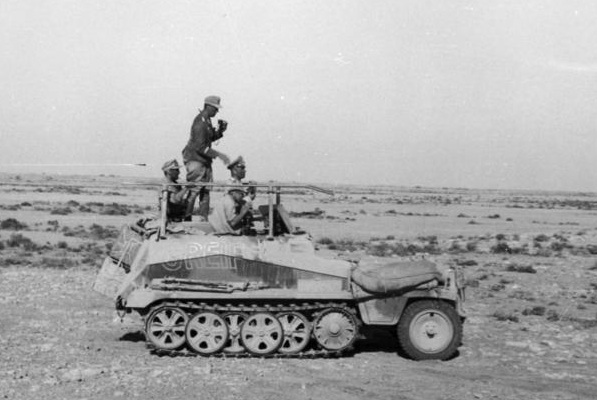
Rommel in a Sd.Kfz. 250/3
The Battle of Alam el Halfa was launched on 30 August. The terrain left Rommel with no choice but to follow a similar tactic as he had at previous battles: the bulk of the forces attempted to sweep around from the south while secondary attacks were launched on the remainder of the front. It took much longer than anticipated to get through the minefields in the southern sector, and the tanks got bogged down in unexpected patches of quicksand (Montgomery had arranged for Rommel to acquire a falsified map of the terrain).[246][247] Under heavy fire from British artillery and aircraft, and in the face of well prepared positions that Rommel could not hope to outflank due to lack of fuel, the attack stalled. By 2 September, Rommel realized the battle was unwinnable, and decided to withdraw.[248]
Montgomery had made preparations to cut the Germans off in their retreat, but in the afternoon of 2 September he visited Corps commander Brian Horrocks and gave orders to allow the Germans to retire. This was to preserve his own strength intact for the main battle which was to come.[249] On the night of 3 September the 2nd New Zealand Division and 7th Armoured Division positioned to the north engaged in an assault, but they were repelled in a fierce rearguard action by the 90th Light Division. Montgomery called off further action to preserve his strength and allow for further desert training for his forces.[250] In the attack Rommel had suffered 2,940 casualties and lost 50 tanks, a similar number of guns, and 400 lorries, vital for supplies and movement. The British losses, except tank losses of 68, were much less, further adding to the numerical inferiority of Panzer Army Afrika. The Desert Air Force inflicted the highest proportions of damage on Rommel's forces. He now realized the war in Africa could not be won.[251] Physically exhausted and suffering from a liver infection and low blood pressure, Rommel flew home to Germany to recover his health.[252][253] General Georg Stumme was left in command in Rommel's absence.[243]
Second Battle of El Alamein
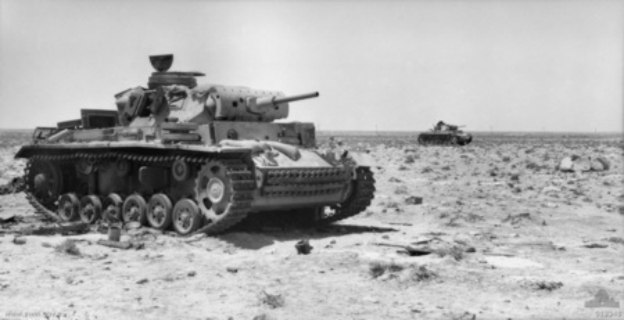
Destroyed Panzer IIIs at Tel el Eisa, near El Alamein (1942)
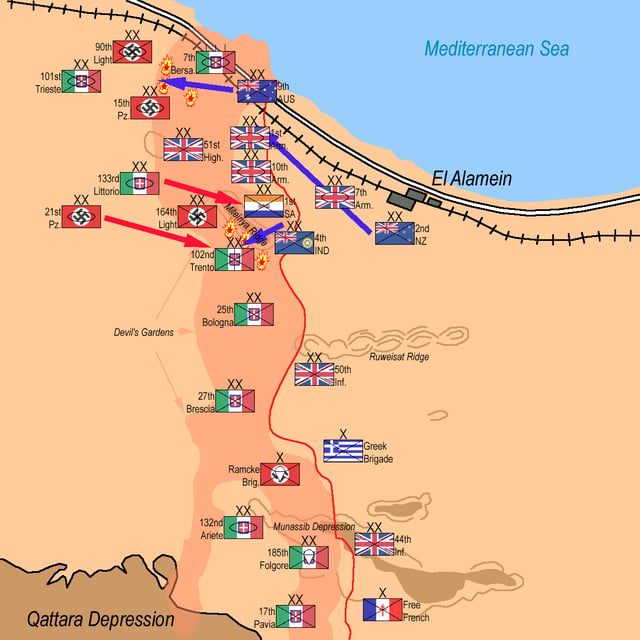
Second Battle of El Alamein. Situation on 28 October 1942
Improved decoding by British intelligence (see Ultra) meant that the Allies had advance knowledge of virtually every Mediterranean convoy, and only 30 percent of shipments were getting through.[254] In addition, Mussolini diverted supplies intended for the front to his garrison at Tripoli and refused to release any additional troops to Rommel.[255] The increasing Allied air superiority and lack of fuel meant Rommel was forced to take a more defensive posture than he would have liked for the second Battle of El Alamein.[256] The German defences to the west of the town included a minefield 5 miles (8 km) deep with the main defensive line – itself several thousand yards deep – to its west.[257] This, Rommel hoped, would allow his infantry to hold the line at any point until motorized and armoured units in reserve could move up and counterattack any Allied breaches.[258] The British offensive began on 23 October. Stumme, in command in Rommel's absence, died of an apparent heart attack while examining the front on 24 October, and Rommel was ordered to return from his medical leave, arriving on the 25th.[259] Montgomery's intention was to clear a narrow path through the minefield at the northern part of the defenses, at the area called Kidney Ridge, with a feint to the south. By the end of 25 October, the 15th Panzer, the defenders in this sector, had only 31 serviceable tanks remaining of their initial force of 119.[260] Rommel brought the 21st Panzer and Ariete Divisions north on 26 October, to bolster the sector. On 28 October, Montgomery shifted his focus to the coast, ordering his 1st and 10th Armoured Divisions to attempt to swing around and cut off Rommel's line of retreat. Meanwhile, Rommel concentrated his attack on the Allied salient at Kidney Ridge, inflicting heavy losses. However, Rommel had only 150 operational tanks remaining, and Montgomery had 800, many of them Shermans.[261]
Montgomery, seeing his armoured brigades losing tanks at an alarming rate, stopped major attacks until the early hours of 2 November, when he opened Operation Supercharge, with a massive artillery barrage.[262] This was followed by penetration at the salient by two armoured and two infantry divisions.[263] Rommel's counterattack at 11:00 inflicted severe casualties on the Commonwealth troops, but by 20:00, with only 35 tanks remaining, he ordered his forces to disengage and begin to withdraw.[264] At midnight, he informed the OKW of his decision, and received a reply directly from Hitler the following afternoon: he ordered Rommel and his troops to hold their position to the last man. Rommel, who believed that the lives of his soldiers should never be squandered needlessly, was stunned.[265] While he (like all members of the Wehrmacht) had pledged an oath of absolute obedience to Hitler, he thought this order was pointless, even madness, and had to be disobeyed.[266] Rommel initially complied with the order, but after discussions with Kesselring and others, he issued orders for a retreat on 4 November.[267] The delay proved costly in terms of his ability to get his forces out of Egypt. He later said the decision to delay was what he most regretted from his time in Africa.[268] Meanwhile, the British 1st and 7th Armoured Division had broken through the German defences and were preparing to swing north and surround the Axis forces.[269] On the evening of the 4th, Rommel finally received word from Hitler authorizing the withdrawal.[270] By this time it was impossible for Rommel to save his non-motorized units.[271][272]
End of Africa campaign
Retreat across Africa
As Rommel attempted to withdraw his forces before the British could cut off his retreat, he fought a series of delaying actions. Heavy rains slowed movements and grounded the Desert Air Force, which aided the withdrawal. According to Kourt von Esebeck, those German parts of Panzerarmee Africa that were motorized slipped away from El Alamein, all vehicles had been taken away from Italian forces, leaving them behind[273], but were under pressure from the pursuing Eighth Army. According to officers of the Italian X Corps, they were not deliberately abandoned and an effort to save all divisions would only have led to destruction of more units.[274] A series of short delaying actions was fought over the coastal highway, but no line could be held for any length of time, as Rommel lacked the armour and fuel to defend his open southern flank.[275] Rommel continued to retreat west, abandoning Halfaya Pass, Sollum, Mersa Brega and El Agheila.[276] The line Rommel was aiming for was 'Gabes gap' in Tunisia.[277] Luftwaffe Field Marshal Kesselring strongly criticized Rommel's decision to retreat all the way to Tunisia, as each airfield the Germans abandoned extended the range of the Allied bombers and fighters. Rommel defended his decision, pointing out that if he tried to assume a defensive position the Allies would destroy his forces and take the airfields anyway; the retreat saved the lives of his remaining men and shortened his supply lines. By now, Rommel's remaining forces fought in reduced strength combat groups, whereas the Allied forces had great numerical superiority and control of the air. Upon his arrival in Tunisia, Rommel noted with some bitterness the reinforcements, including the 10th Panzer Division, arriving in Tunisia following the Allied invasion of Morocco.[278]
Tunisia
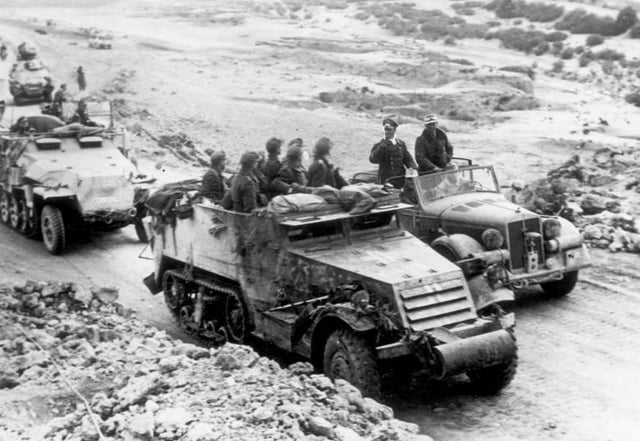
Rommel speaks with troops who are using a captured American M3 half-track, Tunisia.
Having reached Tunisia, Rommel launched an attack against the U.S. II Corps which was threatening to cut his lines of supply north to Tunis. Rommel inflicted a sharp defeat on the American forces at the Kasserine Pass in February, his last battlefield victory of the war, and his first engagement against the United States Army.[279]
Rommel immediately turned back against the British forces, occupying the Mareth Line (old French defences on the Libyan border). While Rommel was at Kasserine at the end of January 1943, the Italian General Giovanni Messe was appointed commander of Panzer Army Africa, renamed the Italo-German Panzer Army in recognition of the fact that it consisted of one German and three Italian corps. Though Messe replaced Rommel, he diplomatically deferred to him, and the two coexisted in what was theoretically the same command. On 23 February Armeegruppe Afrika was created with Rommel in command. It included the Italo-German Panzer Army under Messe (renamed 1st Italian Army) and the German 5th Panzer Army in the north of Tunisia under General Hans-Jürgen von Arnim.
The last Rommel offensive in North Africa was on 6 March 1943, when he attacked Eighth Army at the Battle of Medenine.[280] The attack was made with 10th, 15th, and 21st Panzer Divisions. Alerted by Ultra intercepts, Montgomery deployed large numbers of anti-tank guns in the path of the offensive. After losing 52 tanks, Rommel called off the assault.[281] On 9 March he returned to Germany.[282] Command was handed over to General Hans-Jürgen von Arnim. Rommel never returned to Africa.[283] The fighting there continued on for another two months, until 13 May 1943, when General Messe surrendered the Armeegruppe Afrika to the Allies.
Italy 1943
On 23 July 1943 Rommel was moved to Greece as commander of Army Group E to counter a possible British invasion. He arrived in Greece on 25 July, but was recalled to Berlin the same day due to the overthrow of Mussolini. Rommel was to be posted to Italy as commander of the newly formed Army Group B. On 16 August 1943 Rommel's headquarters moved to Lake Garda in northern Italy and formally assumed command of the army group, which consisted of the 44th Infantry Division, the 26th Panzer Division and the 1st SS Panzer Division Leibstandarte SS Adolf Hitler. When Italy announced its armistice with the Allies on 8 September, his forces took part in Operation Achse, disarming the Italian forces.[284]
Hitler met with Rommel and Kesselring to discuss future operations in Italy on 30 September 1943. Rommel insisted on a defensive line north of Rome, while Kesselring was more optimistic and advocated holding a line south of Rome. Hitler preferred Kesselring's recommendation, and therefore revoked his previous decision for the subordination of Kesselring's forces to Rommel's army group. On 19 October Hitler decided that Kesselring would be the overall commander of the forces in Italy, sidelining Rommel.[285]
Rommel had wrongly predicted that the collapse of the German line in Italy would be fast. On 21 November Hitler gave Kesselring overall command of the Italian theater, moving Rommel and Army Group B to Normandy in France with responsibility for defending the French coast against the long anticipated Allied invasion.[286]
Atlantic Wall 1944
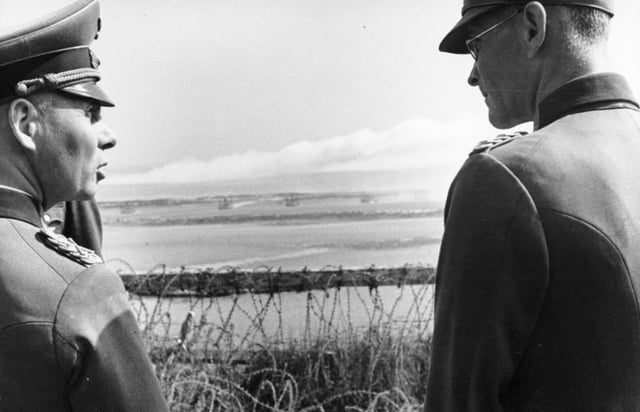
Rommel observes the fall of shot at Riva-Bella, just north of Caen in the area that would become Sword Beach in Normandy.
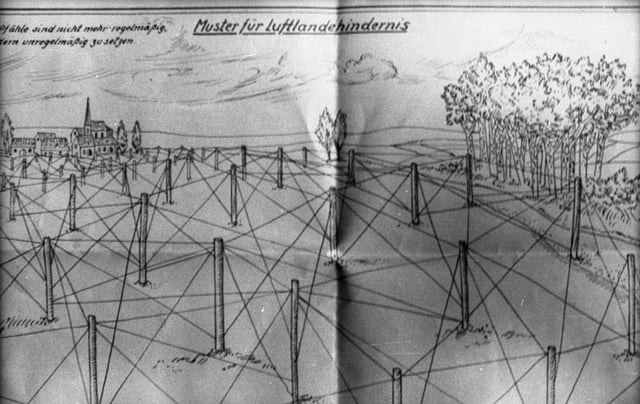
A sketch by Rommel. His words on the picture: "Patterns for anti-airlanding obstacles. Now to be spaced irregularly instead of regularly". The House of Local History of Baden-Württemberg now keeps several of these, some hand-coloured by Rommel himself.[47]
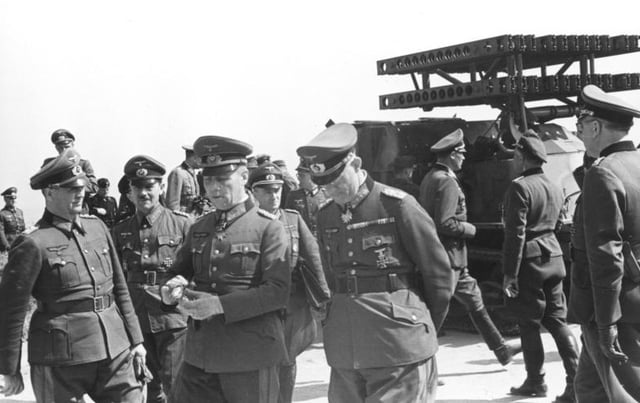
Inspecting 21st Panzer Division troops and a mule track carrier of the Nebelwerfer

Generalfeldmarschälle Gerd von Rundstedt and Erwin Rommel meeting in Paris
On 4 November 1943, Rommel became General Inspector of the Western Defences. He was given a staff that befitted an army group commander, and the powers to travel, examine and make suggestions on how to improve the defences, but not a single soldier. Hitler, who was having a disagreement with him over military matters, intended to use Rommel as a psychological trump card.[287]
There was broad disagreement in the German High Command as to how best to meet the expected allied invasion of Northern France. The Commander-in-Chief West, Gerd von Rundstedt, believed there was no way to stop the invasion near the beaches due to the firepower possessed by the Allied navies, as had been experienced at Salerno.[288] He argued that the German armour should be held in reserve well inland near Paris where they could be used to counter-attack in force in a more traditional military doctrine. The allies could be allowed to extend themselves deep into France where a battle for control would be fought, allowing the Germans to envelop the allied forces in a pincer movement, cutting off their avenue of retreat. He feared the piecemeal commitment of their armoured forces would cause them to become caught in a battle of attrition which they could not hope to win.[288]
The notion of holding the armour inland to use as a mobile reserve force from which they could mount a powerful counterattack applied the classic use of armoured formations as seen in France 1940. These tactics were still effective on the Eastern Front, where control of the air was important but did not dominate the action. Rommel's own experiences at the end of the North African campaign revealed to him that the Germans would not be allowed to preserve their armour from air attack for this type of massed assault.[288] Rommel believed their only opportunity would be to oppose the landings directly at the beaches, and to counterattack there before the invaders could become well established. Though there had been some defensive positions established and gun emplacements made, the Atlantic Wall was a token defensive line. Rundstedt had confided to Rommel that it was for propaganda purposes only.[289]
Upon arriving in Northern France Rommel was dismayed by the lack of completed works. According to Ruge, Rommel was in a staff position and could not issue orders, but he took every effort to explain his plan to commanders down to the platoon level, who took up his words eagerly, but "more or less open" opposition from the above slowed down the process.[290] Finally, Rundstedt, who only respected Rommel grudgingly (he called him Field Marshal Cub),[291][292] intervened and supported Rommel's request for being made a commander.[293] It was granted in 15 January 1944, when "much valuable time had been lost."[290]
He set out to improve the fortifications along the Atlantic Wall with great energy and engineering skill.[6][7][8][9]. This was a compromise: Rommel now commanded the 7th and 15th armies; he also had authority over a 20-kilometer-wide strip of coastal land between Zuiderzee and the mouth of the Loire. The chain of command was convoluted: the airforce and navy had their own chiefs, as did the South and Southwest France and the Panzer group; Rommel also needed Hitler's permissions to use the tank divisions.[297] Undeterred, Rommel had millions of mines laid and thousands of tank traps and obstacles set up on the beaches and throughout the countryside, including in fields suitable for glider aircraft landings, the so-called Rommel's asparagus.[298](The Allies would later counter these with Hobart's Funnies)[299] In April 1944 Rommel promised Hitler that the preparations would be complete by 1 May, but by the time of the Allied invasion the preparations were far from finished. The quality of some of the troops manning them was poor and many bunkers lacked sufficient stocks of ammunition.[298]
Rundstedt expected the Allies to invade in the Pas-de-Calais because it was the shortest crossing point from Britain, its port facilities were essential to supplying a large invasion force, and the distance from Calais to Germany was relatively short.[300] Rommel and Hitler's views on the matter is a matter of debate between authors, with both seeming to change their positions.[301][302][303][304]
Hitler vacillated between the two strategies. In late April, he ordered the I SS Panzer Corps placed near Paris, far enough inland to be useless to Rommel, but not far enough for Rundstedt. Rommel moved those armoured formations under his command as far forward as possible, ordering General Erich Marcks, commanding the 84th Corps defending the Normandy section, to move his reserves into the frontline. Although Rommel was the dominating personality in Normandy with Rundstedt willing to delegate most of the responsibilities to him (the central reserve was Rundstedt's idea but he did not oppose to some form of coastal defense, and gradually came under the influence of Rommel's thinking), Rommel's strategy of an armor-supported coastal defense line was opposed by some officers, most notably Leo Geyr von Schweppenburg, who was supported by Guderian.[305][288][306][307][293][308] Hitler compromised and gave Rommel three divisions (the 2nd, the 21st and the 116th Panzer), let Rundstedt retain four and turned the other three to Army Group G, pleasing no one.[309][310]
The Allies staged elaborate deceptions for D-Day (see Operation Fortitude), giving the impression that the landings would be at Calais. Although Hitler himself expected a Normandy invasion for a while, Rommel and most Army commanders in France believed there would be two invasions, with the main invasion coming at the Pas-de-Calais. Rommel drove defensive preparations all along the coast of Northern France, particularly concentrating fortification building in the River Somme estuary. By D-Day on 6 June 1944 nearly all the German staff officers, including Hitler's staff, believed that Pas-de-Calais was going to be the main invasion site, and continued to believe so even after the landings in Normandy had occurred.[311]
The 5 June storm in the channel seemed to make a landing very unlikely, and a number of the senior officers were away from their units for training exercises and various other efforts. On 4 June the chief meteorologist of the 3 Air Fleet reported that weather in the channel was so poor there could be no landing attempted for two weeks. On 5 June Rommel left France and on 6 June he was at home celebrating his wife's birthday.[298] He was recalled and returned to his headquarters at 10 pm. Meanwhile, earlier in the day, Rundstedt had requested the reserves be transferred to his command. At 10 am Keitel advised that Hitler declined to release the reserves but that Rundstedt could move the 12th SS Panzer Division Hitlerjugend closer to the coast, with the Panzer-Lehr-Division placed on standby. Later in the day, Rundstedt received authorisation to move additional units in preparation for a counterattack, which Rundstedt decided to launch on 7 June. Upon arrival, Rommel concurred with the plan. By nightfall, Rundstedt, Rommel and Speidel continued to believe that the Normandy landing might have been a diversionary attack, as the Allied deception measures still pointed towards Calais. The 7 June counterattack did not take place as the 12th SS did not arrive on time due to the Allied air bombardments.[312] All this made the German command structure in France in disarray during the opening hours of the D-Day invasion.[313]
Facing relatively small-scale German counterattacks, the Allies secured five beachheads by nightfall of 6 June, landing 155,000 troops.[314] The Allies pushed ashore and expanded their beachhead despite strong German resistance. Rommel believed that if his armies pulled out of range of Allied naval fire, it would give them a chance to regroup and re-engage them later with a better chance of success. While he managed to convince Rundstedt, they still needed to win over Hitler. At a meeting with Hitler in Margival on 17 June, Rommel warned Hitler about the inevitable collapse in the German defences, but was rebuffed and told to focus on military operations.[315][316]
By mid-July the German position was crumbling. On 17 July 1944, as Rommel was returning from visiting the headquarters of the I SS Panzer Corps, a fighter piloted by Charley Fox of 412 Squadron,[317] or Jacques Remlinger of No. 602 Squadron RAF[318][319] or Johannes Jacobus le Roux of No. 602 Squadron RAF[320] strafed his staff car near Sainte-Foy-de-Montgommery. The driver sped up and attempted to get off the main roadway, but a 20 mm round shattered his left arm, causing the vehicle to veer off of the road and crash into trees. Rommel was thrown from the car, suffering injuries to the left side of his face from glass shards and three fractures to his skull.[317][321] He was hospitalised with major head injuries (assumed to be almost certainly fatal).[322]
Plot against Hitler
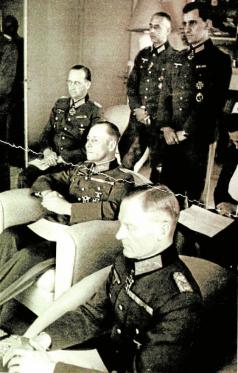
A meeting between the military resistance's inner circle and Rommel, Mareil-Marly, 15. May 1944. From left, Speidel - behind, Rommel - center, von Stülpnagel - front. The officer standing left is Rudolf Hartmann. The others are unknown.
The role that Rommel played in the military's resistance against Hitler or the 20 July plot is difficult to ascertain, as most of the leaders who were directly involved did not survive and limited documentation on the conspirators' plans and preparations exists.[323][324] One piece of evidence that points to the possibility that Rommel came to support the assassination plan was General Eberbach's confession to his son (eavesdropped on by British agencies) while in British captivity, which stated that Rommel explicitly said to him that Hitler and his close associates had to be killed because this would be the only way out for Germany. [285] [326][327][328] This conversation occurred about a month before Rommel was coerced into committing suicide. Other notable evidence includes the papers of Rudolf Hartmann (who survived the later purge) and Carl-Heinrich von Stülpnagel, who were among the leaders of the military resistance (alongside General Hans Speidel, Colonel Karl-Richard Koßmann, Colonel Eberhard Finckh and Lieutenant Colonel Caesar von Hofacker). These papers, accidentally discovered by historian Christian Schweizer in 2018 while doing research on Rudolf Hartmann, include Hartmann's eyewitness account of a conversation between Rommel and Carl-Heinrich von Stülpnagel in May 1944, as well as photos of the mid-May 1944 meeting between the inner circle of the resistance and Rommel at Kossmann's house. According to Hartmann, by the end of May, in another meeting at Hartmann's quarters in Mareil-Marly, Rommel showed "decisive determination" and clear approval of the inner circle's plan.[329]
According to a post-war account by Karl Strölin, three of Rommel's friends—the Oberbürgermeister of Stuttgart, Strölin (who had served with Rommel in the First World War), Alexander von Falkenhausen and Carl Heinrich von Stülpnagel—began efforts to bring Rommel into the anti-Hitler conspiracy in early 1944. According to Strölin, sometime in February, Rommel agreed to lend his support to the resistance.[330] On 15 April 1944 Rommel's new chief of staff, Hans Speidel, arrived in Normandy and reintroduced Rommel to Stülpnagel.[331] Speidel had previously been connected to Carl Goerdeler, the civilian leader of the resistance, but not to the plotters led by Claus von Stauffenberg, and came to Stauffenberg's attention only due to his appointment to Rommel's headquarters. The conspirators felt they needed the support of a field marshal on active duty. Erwin von Witzleben, who would have become commander-in-chief of the Wehrmacht had the plot succeeded, was a field marshal, but had been inactive since 1942. The conspirators gave instructions to Speidel to bring Rommel into their circle.[332]
Speidel met with former foreign minister Konstantin von Neurath and Strölin on 27 May in Germany, ostensibly at Rommel's request, although the latter was not present. Neurath and Strölin suggested opening immediate surrender negotiations in the West, and, according to Speidel, Rommel agreed to further discussions and preparations.[316] Around the same timeframe, the plotters in Berlin were not aware that Rommel had allegedly decided to take part in the conspiracy. On 16 May, they informed Allen Dulles, through whom they hoped to negotiate with the Western Allies, that Rommel could not be counted on for support.[333]
At least initially, Rommel opposed assassinating Hitler.[334] According to some authors,[335][336][337][338][339] he gradually changed his attitude. After the war, his widow—among others—maintained that Rommel believed an assassination attempt would spark civil war in Germany and Austria, and Hitler would have become a martyr for a lasting cause.[340] Instead, Rommel reportedly suggested that Hitler be arrested and brought to trial for his crimes; he did not attempt to implement this plan when Hitler visited Margival, France, on 17 June. The arrest plan would have been highly improbable, as Hitler's security was extremely tight. Rommel would have known this, having commanded Hitler's army protection detail in 1939.[341] He was in favour of peace negotiations, and repeatedly urged Hitler to negotiate with the Allies, which is dubbed by some as "hopelessly naive", considering no one would trust Hitler,[342][44][343] and "as naive as it was idealistic, the attitude he showed to the man he had sworn loyalty".[344] According to Reuth, the reason Lucie Rommel did not want her husband to be associated with any conspiracy was that even after the war, the German population neither grasped nor wanted to comprehend the reality of the genocide, thus conspirators were still treated as traitors and outcasts.[345] On the other hand, the resistance depended on the reputation of Rommel to win over the population.[346][347] Some officers who had worked with Rommel also recognized the relationship between Rommel and the resistance: Westphal said that Rommel did not want any more senseless sacrifices.[346] Butler, using Ruge's recollections, reports that when told by Hitler himself that "no one will make peace with me", Rommel told Hitler that if he was the obstacle for peace, he should resign or kill himself, but Hitler insisted on fanatical defense.[348] Reuth, based on Jodl's testimony, reports that Rommel forcefully presented the situation and asked for political solutions from Hitler, who rebuffed that Rommel should leave politics to him.[349] Brighton comments that Rommel seemed devoted, even though he did not have much faith in Hitler anymore, considering he kept informing Hitler in person and by letter about his changing beliefs, despite facing a military dilemma as well as a personal struggle.[350] Lieb remarks that Rommel's attitude in describing the situation honestly and requiring political solutions was almost without precedent and contrary to the attitude of many other generals.[351][337] Remy comments that Rommel put himself and his family (which he had briefly considered evacuating to France, but refrained from doing so) at risk for the resistance out of a combination of his concern for the fate of Germany, his indignation at atrocities and the influence of people around him.[352]
On 15 July, Rommel wrote a letter to Hitler giving him a "last chance" to end the hostilities with the Western Allies, urging Hitler to "draw the proper conclusions without delay." What Rommel did not know was that the letter took two weeks to reach Hitler because of Kluge's precautions.[353][354] Various authors report that many German generals in Normandy, including some SS officers like Hausser, Bittrich, Dietrich (a hard-core Nazi and Hitler's long-time supporter) and Rommel's former opponent Geyr von Schweppenburg pledged support to him, even against Hitler's orders, while Kluge supported him with much hesitation.[355][356][323][357] Von Rundstedt encouraged Rommel to carry out his plans but refused to do anything himself, remarking that it had to be a man who was still young and loved by the people,[358][359] while von Manstein was also approached by Rommel but categorically refused, although he did not report them to Hitler either.[360][361] Peter Hoffmann reports that he also attracted into his orbit officials who had previously refused to support the conspiracy, like Julius Dorpmüller and Karl Kaufmann (According to Russell A. Hart, reliable details of the conversations are now lost, although they certainly met.)[347][362]
On 17 July, Rommel was incapacitated by an Allied air attack, which many authors describe as a fateful event that drastically altered the outcome of the bomb plot.[363][364][365][366][367][368][369] Writer Ernst Jünger commented: "The blow that felled Rommel ... robbed the plan of the shoulders that were to be entrusted the double weight of war and civil war - the only man who had enough naivety to counter the simple terror that those he was about to go against possessed."[370]
After the failed bomb attack of 20 July, many conspirators were arrested and the dragnet expanded to thousands.[371] Rommel was first implicated when Stülpnagel, after his suicide attempt, repeatedly muttered "Rommel" in delirium.[372][373] Under torture, Hofacker named Rommel as one of the participants.[374] Additionally, Goerdeler had written down Rommel's name on a list as potential Reich President (according to Stroelin, they had not managed to announce this intention to Rommel yet and he probably never heard of it until the end of his life).[375][376][377][378][379][380] On 27 September, Martin Bormann submitted to Hitler a memorandum which claimed that "the late General Stülpnagel, Colonel von Hofacker, Kluge's nephew who has been executed, Lieutenant Colonel Rathgens, and several ... living defendants have testified that Field Marshal Rommel was perfectly in the picture about the assassination plan and has promised to be at the disposal of the New Government."[381][382] Gestapo agents were sent to Rommel's house in Ulm and placed him under surveillance.[383]
Historian Peter Lieb considers the memorandum, as well as Eberbach's conversation and the testimonies of surviving resistant members (including Hartmann) to be the three key sources that indicate Rommel's support of the assassination plan. He further notes that while Speidel had an interest in promoting his own post-war career, his testimonies should not be dismissed, considering his bravery as an early resistance figure.[384] Remy writes that even more important than Rommel's attitude to the assassination is the fact Rommel had his own plan to end the war. He began to contemplate this plan some months after El Alamein and carried it out with a lonely decision and conviction, and in the end, had managed to bring military leaders in the West to his side.[385]
Death

Rommel's funeral procession
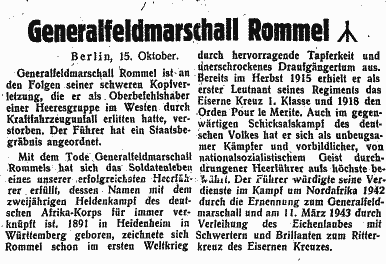
The official announce of Erwin Rommel's death by the Nazi newspaper "Bozner Tagblatt", 16 October 1944

Tomb of Erwin Rommel in Herrlingen (2019)
Rommel's case was turned over to the "Court of Military Honour"—a drumhead court-martial convened to decide the fate of officers involved in the conspiracy. The court included Generalfeldmarshall Wilhelm Keitel, Generalfeldmarshall Gerd von Rundstedt, Generaloberst Heinz Guderian, General der Infanterie Walther Schroth and Generalleutnant Karl-Wilhelm Specht, with General der Infanterie Karl Kriebel and Generalleutnant Heinrich Kirchheim (whom Rommel had fired after Tobruk in 1941)[187] as deputy members and Generalmajor Ernst Maisel as protocol officer. The Court acquired information from Speidel, Hofacker and others that implicated Rommel, with Keitel and Ernst Kaltenbrunner assuming that he had taken part in the subversion. Keitel and Guderian then made the decision that favoured Speidel's case and at the same time shifted the blame to Rommel.[386][387][388] By normal procedure, this would lead to Rommel's being brought to Roland Freisler's People's Court, a kangaroo court that always decided in favour of the prosecution. However, Hitler knew that having Rommel branded and executed as a traitor would severely damage morale on the home front.[389][390] He thus decided to offer Rommel the chance to take his own life.[391]
Two generals from Hitler's headquarters, Wilhelm Burgdorf and Ernst Maisel, visited Rommel at his home on 14 October 1944. Burgdorf informed him of the charges and offered him three options: he could choose to defend himself personally to Hitler in Berlin,[10] or if he refused to do so (which would be taken as an admission of guilt), he would either face the People's Court—which would have been tantamount to a death sentence—or choose a quiet suicide. In the former case, his family would have suffered even before the all-but-certain conviction and execution, and his staff would have been arrested and executed as well. In the latter case, the government would claim that he died a hero and bury him with full military honours, and his family would receive full pension payments. Burgdorf had brought a cyanide capsule.[393]
Rommel denied involvement in the plot, declaring his love for Hitler, and saying that he would gladly serve his "Fatherland" again.[394] Der Spiegel notes that he was talking to the "messengers of death" – Burgdorf and Maisel – and some would claim that he was acting out of helpless defense – although Der Spiegel thought his love for Hitler was sincere.[395] Remy, however, suggests that Rommel was trying in some way to apologise to Hitler about whom he had conflicting emotions, which Maisel[396][397] realised and found "disgusting" and "a hypocrisy", because Maisel – a loyal, unapologetic Hitler supporter, even after the war – could not understand how someone could try to kill someone he loved; Rommel's previous replies about his role in the attempt had made Maisel believe that he was part of the plot.[398][399][400][401][11][402]
Before the two officers came, Rommel had told his family and friends that he would not reach Berlin alive, considering the fact that he appeared before a court "would be the end of Hitler", too.[402] He now realized that an SS detachment had surrounded his village and he could not contact even his headquarters.[403] With that in mind, Rommel opted to commit suicide, and explained his decision to his wife and son.[403] Wearing his Afrika Korps jacket and carrying his field marshal's baton, Rommel went to Burgdorf's Opel, driven by SS Master Sergeant Heinrich Doose, and was driven out of the village. After stopping, Doose and Maisel walked away from the car, leaving Rommel with Burgdorf. Five minutes later Burgdorf gestured to the two men to return to the car, and Doose noticed that Rommel was slumped over, having taken the cyanide. He died before being taken to the Wagner-Schule field hospital. Ten minutes later, the group telephoned Rommel's wife to inform her of his death.[404][405][406][407] Witnesses were struck by the smile of deep contempt on the dead man's face, never seen in life, and his widow thought it was for Hitler.[408][409]
The official story of Rommel's death, as reported to the public, stated that Rommel had died of either a heart attack or a cerebral embolism—a complication of the skull fractures he had suffered in the earlier strafing of his staff car.[410][411][412][413] To strengthen the story still further, Hitler ordered an official day of mourning in commemoration. As previously promised, Rommel was given a state funeral. The fact that his state funeral was held in Ulm instead of Berlin had, according to his son, been stipulated by Rommel.[414]. Hitler sent Field Marshal von Rundstedt, who was unaware that Rommel had died as a result of Hitler's orders, as his representative at Rommel's funeral.[415] The body was cremated so no incriminating evidence would be left.[408] The truth behind Rommel's death became known to the Allies when intelligence officer Charles Marshall interviewed Rommel's widow, Lucia Rommel,[416] as well as from a letter by Rommel's son Manfred in April 1945.[417]
Rommel's grave is located in Herrlingen, a short distance west of Ulm. For decades after the war on the anniversary of his death, veterans of the Africa campaign, including former opponents, would gather at his tomb in Herrlingen.[418]
Rommel's style as military commander
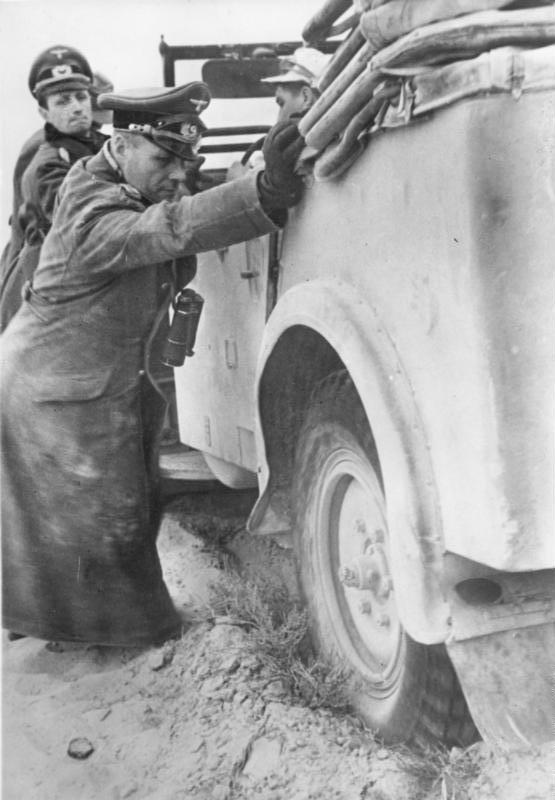
Rommel helping to free up his staff car, a Škoda Superb Kfz 21[449]
On the Italian front in the First World War Rommel was a successful tactician in fast-developing mobile battle, and this shaped his subsequent style as a military commander. He found that taking initiative and not allowing the enemy forces to regroup led to victory. Some authors, like Porch, comment that his enemies were often less organised, second-rate, or depleted, and his tactics were less effective against adequately led, trained and supplied opponents and proved insufficient in the later years of the war.[419] Others point out that through his career, he frequently fought while out-numbered and out-gunned, sometimes overwhelmingly so, while having to deal with internal opponents in Germany who hoped that he would fail.[420][421][422][423][424][425][426][427][428][429][12]
Rommel is praised by numerous authors as a great leader of men.[13][431][432][433][434][435][436][437][438][439][440][441][442][443][444] The historian and journalist Basil Liddell Hart concludes that he was a strong leader worshipped by his troops, respected by his adversaries and deserving to be named as one of the "Great Captains of History."[445] Owen Connelly concurs, writing that "No better exemplar of military leadership can be found" and quoting Friedrich von Mellenthin on the inexplicable mutual understanding that existed between Rommel and his troops.[446] Hitler, though, remarked that, "Unfortunately Field-Marshal Rommel is a very great leader full of drive in times of success, but an absolute pessimist when he meets the slightest problems."[447] Telp criticises Rommel for not extending the benevolence he showed in promoting his own officers' careers to his peers, who he ignored or slighted in his reports.[448]
Taking his opponents by surprise and creating uncertainty in their minds were key elements in Rommel's approach to offensive warfare: he took advantage of sand storms and the dark of night to conceal the movement of his forces.[450] He was aggressive and often directed battle from the front or piloted a reconnaissance aircraft over the lines to get a view of the situation. When the British mounted a commando raid deep behind German lines in an effort to kill Rommel and his staff on the eve of their Crusader offensive, Rommel was indignant that the British expected to find his headquarters 250 miles behind his front.[451] Mellenthin and Harald Kuhn write that at times in North Africa his absence from a position of communication made command of the battles of the Afrika Korps difficult. Mellenthin lists Rommel's counterattack during Operation Crusader as one such instance.[452][453] Butler concurred, saying that leading from the front is a good concept but Rommel took it so far - he frequently directed the actions of a single company or battalion - that he made communication and coordination between units problematic, as well as risking his life to the extent that he could easily have been killed even by his own artillery.[133] Kesselring also complained about Rommel cruising about the battlefield like a division or corps commander; but Gause and Westphal, supporting Rommel, replied that in the African desert only this method would work and that it was useless to try to restrain Rommel anyway.[454][455] His staff officers, although admiring towards their leader, complained about the self-destructive Spartan lifestyle that made life harder, diminished his effectiveness and forced them to "bab[y] him as unobtrusively as possible."[456][457][458]
For his leadership during the French campaign Rommel received both praise and criticism. Many, such as General Georg Stumme, who had previously commanded 7th Panzer Division, were impressed with the speed and success of Rommel's drive.[459] Others were reserved or critical: Kluge, his commanding officer, argued that Rommel's decisions were impulsive and that he claimed too much credit, by falsifying diagrams or by not acknowledging contributions of other units, especially the Luftwaffe. Some pointed out that Rommel's division took the highest casualties in the campaign.[460] Others point out that in exchange for 2,160 casualties and 42 tanks, it captured more than 100,000 prisoners and destroyed nearly two divisions' worth of enemy tanks (about 450 tanks), vehicles and guns.[461][462]
Rommel spoke German with a pronounced southern German or Swabian accent. He was not a part of the Prussian aristocracy that dominated the German high command, and as such was looked upon somewhat suspiciously by the Wehrmacht's traditional power structure.[463][464] Rommel felt a commander should be physically more robust than the troops he led, and should always show them an example.[465][14] He expected his subordinate commanders to do the same.[466]
Rommel was direct, unbending, tough in his manners, to superiors and subordinates alike, disobedient even to Hitler whenever he saw fit, although gentle and diplomatic to the lower ranks (German and Italian alike) and POWs.[467][468][469][470][471] Despite being publicity-friendly, he was also shy, introverted, clumsy and overly formal even to his closest aides, judging people only on their merits, although loyal and considerate to those who had proved reliability, and he displayed a surprisingly passionate and devoted side to a very small few (including Hitler) with whom he had dropped the seemingly impenetrable barriers. Many of these traits seemed to manifest even at a very young age.[472][473][474][475]
Relations with Italian forces
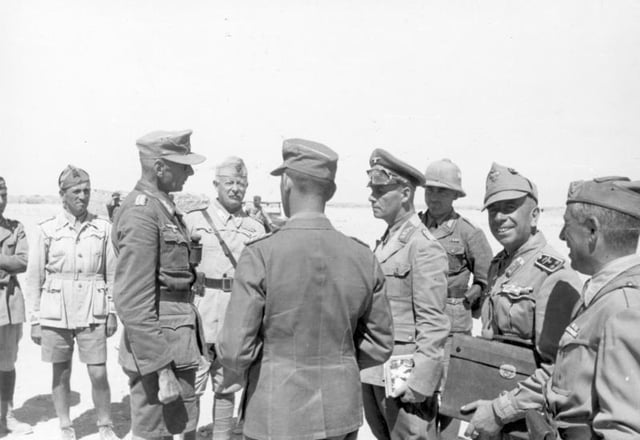
Rommel with German and Italian officers, 1942
Rommel's relationship with the Italian High Command in North Africa was generally poor. Although he was nominally subordinate to the Italians, he enjoyed a certain degree of autonomy from them; since he was directing their troops in battle as well as his own, this was bound to cause hostility among Italian commanders. Conversely, as the Italian command had control over the supplies of the forces in Africa, they resupplied Italian units preferentially, which was a source of resentment for Rommel and his staff.[476] Rommel's direct and abrasive manner did nothing to smooth these issues.[477][478][479]
While certainly much less proficient than Rommel in their leadership, aggressiveness, tactical outlook and mobile warfare skills,[480] Italian commanders were competent in logistics, strategy and artillery doctrine: their troops were ill-equipped but well-trained. As such, the Italian commanders were repeatedly at odds with Rommel over concerns with issues of supply.[481] Field Marshal Kesselring was assigned Supreme Commander Mediterranean, at least in part to alleviate command problems between Rommel and the Italians. This effort resulted only in partial success, with Kesselring's own relationship with the Italians being unsteady and Kesselring claiming Rommel ignored him as readily as he ignored the Italians.[482][483] Rommel often went directly to Hitler with his needs and concerns, taking advantage of the favoritism that the Führer displayed towards him and adding to the distrust that Kesselring and the German High Command already had of him.[484]
According to Scianna, opinion among the Italian military leaders was not unanimous. In general, Rommel was a target of criticism and a scapegoat for defeat rather than a glorified figure, with certain generals also trying to replace him as the heroic leader or hijack the Rommel myth for their own benefit. Nevertheless, he never became a hated figure, although the "abandonment myth", despite being repudiated by officers of the X Corps themselves, was long-lived. Many found Rommel's chaotic leadership and emotional character hard to work with, yet the Italians held him in higher regard than other German senior commanders, militarily and personally.[485]
Very different, however, was the perception of Rommel by Italian common soldiers and NCOs, who, like the German field troops, had the deepest trust and respect for him.[486][15] Paolo Colacicchi, an officer in the Italian Tenth Army recalled that Rommel "became sort of a myth to the Italian soldiers" and that the Bersaglieri baptised him "Rommelito"[487] (This may also have been a reference to both men's small stature: "Rommelito" means "little Rommel" while Romulus means "the little boy from Rome". Incidentally, Palestine Jews associated Rommel with Romulus as well, based on Ohr Hachaim's 200-year-old commentary on the account of Jacob wrestling with the angel.[488]) Rommel himself held a much more generous view about the Italian soldier[489] than about their leadership, towards whom his disdain, deeply rooted in militarism, was not atypical, although unlike Kesselring he was incapable of concealing it.[490] Unlike many of his superiors and subordinates who held racist views, he was usually "kindly disposed" to the Italians in general.[491]
Some authors like Sadkovich blame Rommel for abandoning his Italian units, refusing cooperation, rarely acknowledging their achievements and other improper behaviour towards his Italian allies.[492] However, others point out that the Italians under Rommel, in comparison with many of their compatriots in other areas, were better led, supplied, and trained, fighting well as a result, with a ratio of wounded and killed Italians similar to that of the Germans.[480][493][494][495] In one case, a false accusation of Rommel's supposed mistreatment of Italians made by Goering was refuted by Mussolini himself.[496] In 1943, Jodl stated that the only German commander numerous officers and soldiers in Italy would willingly subordinate themselves to would be Rommel.[497]
Views on the conduct of war
Combat
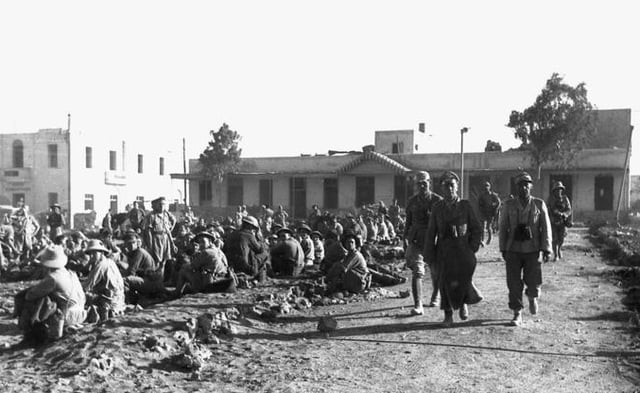
Rommel walks past Allied prisoners taken at Tobruk, 1942
Many authors describe Rommel as having a reputation of being a chivalrous, humane, and professional officer, and that he earned the respect of both his own troops and his enemies.[498][499][500][501][502][503][504][505][506][507] Rommel described the conduct of the desert war as "War without Hate" in his papers, and according to Young's biography and Luck's memoirs, during the desert campaign German and British troops encountering each other between battles were sometimes openly friendly.[508][509]
According to Maurice Remy, orders issued by Hitler during Rommel's stay in a hospital resulted in massacres in the course of Operation Achse, disarming the Italian forces after the armistice with the Allies in 1943, but Rommel treated his Italian opponents with his usual fairness, requiring that the prisoners should be accorded the same conditions as German civilians. Remy opines that an order in which Rommel, in fact protesting against Hitler's directives, called for no "sentimental scruples" against "Badoglio-dependent bandits in uniforms of the once brothers-in-arms" should not be taken out of context.[510] Peter Lieb agrees that the order did not radicalize the war and that the disarmament in Rommel's area of responsibility happened without major bloodshed.[511] Italian internees were sent to Germany for forced labour, but Rommel was unaware of this.[510][511]
In the Normandy campaign both Allied and German troops murdered prisoners of war on occasion during June and July 1944.[512] But Rommel withheld Hitler's Commando Order to execute captured commandos from his Army Group B, with his units reporting that they were treating commandos as regular POWs. It is likely that he had acted similarly in North Africa;[513] though this is disputed by historian Szymon Datner, who writes that Rommel may have been simply trying to conceal atrocities of Nazi Germany from the Allies.[514] Other authors argue that generosity to opponents was a natural trait of the man. Telp states that Rommel by nature was chivalrous and not prone to order needless violence.[515] Robert Forczyk considers Rommel a true great captain with chivalry.[474] Remy states that although Rommel had heard rumours about massacres while fighting in Africa, his personality combined with special circumstances to mean that he was not fully confronted with the reality of atrocities before 1944.[516] When Rommel learned about the atrocities SS Division Leibstandarte committed in Italy in September 1943, he allegedly forbade his son to join the Waffen-SS.[517]
Politics
Some authors cite, among other cases, Rommel's naive reaction to events in Poland while he was there: he paid a visit to his wife's uncle, famous Polish priest and patriotic leader Edmund Roszczynialski, who was murdered within days, but Rommel never understood this and, at his wife's urgings, kept writing letter after letter to Himmler's adjutants asking them to keep track and take care of their relative.[518][519][520] Knopp and Mosier agree that he was naive politically, citing his request for a Jewish Gauleiter in 1943.[521][522] Despite this, Lieb finds it hard to believe that a man in Rommel's position could have known nothing about atrocities, while accepting that locally he was separated from the places where these atrocities occurred.[337] Der Spiegel comments that Rommel was simply in denial about what happened around him.[47] Alaric Searle points out that it was the early diplomatic successes and bloodless expansion that blinded Rommel to the true nature of his beloved Führer, whom he then naively continued to support.[523] Scheck believes it may be forever unclear whether Rommel recognized the unprecedented depraved character of the regime.[44]
Civilians
Historian Richard J. Evans has stated that German soldiers in Tunisia raped Jewish women, and the success of Rommel's forces in capturing or securing Allied, Italian and Vichy French territory in North Africa led to many Jews in these areas being killed by other German institutions as part of the Holocaust.[524] More specifically, several German historians have argued that while Rommel did not have strong racial views, if he had succeeded in his goal of invading the Middle East during 1942 large numbers of Jews in Palestine would have been murdered by an SS unit which had been deployed to North Africa in July 1942 to operate behind the lines of the Afrika Korps.[47] According to Mallmann and Cüppers, a post-war CIA report described Rommel as having met with Walther Rauff, who was responsible for the unit, and been disgusted after learning about the plan from him and as having sent him on his way; but they conclude that such a meeting is hardly possible as Rauff was sent to report to Rommel at Tobruk on 20 July and Rommel was then 500 km away conducting the First El Alamein.[525] On 29 July, Rauff's unit was sent to Athens, expecting to enter Africa when Rommel crossed the Nile. However, in view of the Axis' deteriorating situation in Africa it returned to Germany in September.[526] Historian Jean-Christoph Caron opines that there is no evidence that Rommel knew or would have supported Rauff's mission; he also believes Rommel bore no direct responsibility regarding the SS's looting of gold in Tunisia.[527] Historian Haim Saadon, Director of the Center of Research on North African Jewry in WWII, goes further, stating that there was no extermination plan: Rauff's documents show that his foremost concern was helping the Wehrmacht to win, and he came up with the idea of forced labour camps in the process.[528][529] By the time these labour camps were in operation, according to Ben Shepherd, Rommel had already been retreating and there is no proof of his contact with the Einsatzkommando.[530] The Haaretz comments that the CIA report is most likely correct regarding both the interaction between Rommel and Rauff and Rommel's objections to the plan: Rauff's assistant Theodor Saevecke, and declassified information from Rauff's file, both report the same story. The Haaretz also remarks that Rommel's influence probably softened the Nazi authorities' attitude to the Jews and to the civilian population generally in North Africa.[531]
Historian Martin Kitchen states that the reputation of the Afrika Korps was preserved due to circumstances: the sparsely populated desert areas did not lend themselves to ethnic cleansing; the German forces never reached the large Jewish populations in Egypt and Palestine; and in the urban areas of Tunisia and Tripolitania the Italian government constrained the German efforts to discriminate against or eliminate Jews who were Italian citizens.[532] Despite this, the North African Jews themselves believed that it was Rommel who prevented the "Final Solution" from being carried out against them when German might dominated North Africa from Egypt to Morocco.[533][534] According to Curtis and Remy, 120,000 Jews lived in Algeria, 200,000 in Morocco, about 80,000 in Tunisia (and this number was unchanged following the German invasion of Tunisia in 1942),[535] and 26,000 in Libya.[536] According to Marshall, Rommel sharply protested the Jewish policies and other immoralities and was an opponent of the Gestapo.[537] He also refused to comply with Hitler's order to execute Jewish POWs.[538][16] His own Afrika Korps was known among soldiers of Jewish descent as a refuge, safe from racial laws and discrimination.[539])
Building the Atlantic Wall was officially the responsibility of the Organisation Todt,[543] which was not under Rommel's command, but he enthusiastically joined the task,[544] protesting slave labour and suggesting that they should recruit French civilians and pay them good wages.[545][546] Despite this, French civilians and Italian prisoners of war held by the Germans were forced by officials under the Vichy government,[547] the Todt Organization and the SS forces[548] to work on building some of the defences Rommel requested, in appalling conditions according to historian Will Fowler. Although they got basic wages, the workers complained because it was too little and there was no heavy equipment.[547][549][550][551] Robin Neillands and Roderick De Normann report that German soldiers as well as Russian and Polish renegades were used, to avoid using forced labour.[552] German troops worked almost round-the-clock under very harsh conditions, with Rommel's rewards being accordions. (Rommel was himself an eccentric and horrible violinist.)[553][554][555] Lieb reports that Rommel felt pity when he saw the suffering of the French in his inspection tour and probably helped to save the lives of thousands of locals.[513]
Spoils
Rick Atkinson criticises Rommel for gaining a looted stamp collection (a bribe from Sepp Dietrich) and a villa taken from Jews.[556] Lucas, Matthews and Remy though describe the contemptuous and angry reaction of Rommel towards Dietrich's act and the lootings and other brutal behaviours of the SS that he had discovered in Italy.[557][558] Claudia Hecht also explains that although the Stuttgart and Ulm authorities did arrange for the Rommel family to use a villa whose Jewish owners had been forced out two years earlier, for a brief period after their own house had been destroyed by Allied bombing, ownership of it was never transferred to them.[559] Butler notes that Rommel was one of the few who refused large estates and gifts of cash Hitler gave to his generals.[560]
Personal conduct
Curiously, recent research by Norman Ohler claims that Rommel's behaviours were heavily influenced by Pervitin which he reportedly took in heavy doses, to such an extent that Ohler refers to him as "the Crystal Fox" ("Kristallfuchs")[561][562] – playing off the nickname "Desert Fox" famously given to him by the British.[563][564]
In Nazi and Allied propaganda
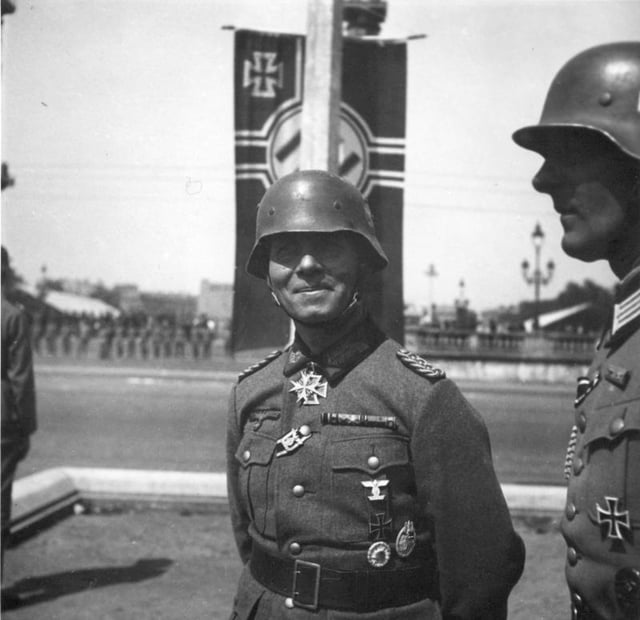
Rommel at a Paris victory parade (June 1940). Rommel had access to Reich Minister of Propaganda Joseph Goebbels via a senior propaganda official Karl Hanke, who served under Rommel during the 1940 campaign.[575]
At the beginning, although Hitler and Goebbels took particular notice of Rommel, the Nazi elites had no intent to create one major war symbol (partly out of fear that he would offset Hitler[565][566]), generating huge propaganda campaigns for not only Rommel but also Gerd von Rundstedt, Walther von Brauchitsch, Eduard Dietl, Sepp Dietrich (the latter two were party members and also strongly supported by Hitler), etc.[567][363][568] Despite this, due to a multitude of conditions such as Rommel's unusual charisma,[17][18] his talents both in military matters and public relations[570][19] as well as no small help from Goebbels' propaganda machine and the Allies's participation in mythologizing his life (either for political benefits,[567] sympathy for someone who evoked a romantic archetype,[572] or genuine admiration for his actions[573]), the situation gradually developed to the point that, as Spiegel described, "Even back then his fame outshone that of all other commanders."
Rommel's victories in France were featured in the German press and in the February 1941 film Victory in the West, in which Rommel personally helped direct a segment reenacting the crossing of the Somme River.[574] Rommel's victories in 1941 were played up by the Nazi propaganda, even though his successes in North Africa were achieved in arguably one of Germany's least strategically important theaters of World War II.[139][20] In November 1941, Reich Minister of Propaganda Joseph Goebbels wrote about "the urgent need" to have Rommel "elevated to a kind of popular hero." Rommel, with his innate abilities as a military commander and love of the spotlight, was a perfect fit for the role Goebbels designed for him.[139]
Successes in North Africa
In North Africa, Rommel received help in cultivating his image from Alfred Ingemar Berndt, a senior official at the Reich Propaganda Ministry who had volunteered for military service.[576] Seconded by Goebbels, Berndt was assigned to Rommel's staff and became one of his closest aides. Berndt often acted as liaison between Rommel, the Propaganda Ministry, and the Führer Headquarters. He directed Rommel's photo shoots and filed radio dispatches describing the battles.[577][578]
In the spring of 1941, Rommel's name began to appear in the British media. In the autumn of 1941 and early winter of 1941/1942, he was mentioned in the British press almost daily. Toward the end of the year, the Reich propaganda machine also used Rommel's successes in Africa as a diversion from the Wehrmacht's challenging situation in the Soviet Union with the stall of Operation Barbarossa.[579][580][21] The American press soon began to take notice of Rommel as well, following the country's entry into the war on 11 December 1941, writing that "The British (...) admire him because he beat them and were surprised to have beaten in turn such a capable general." General Auchinleck distributed a directive to his commanders seeking to dispel the notion that Rommel was a "superman".[581][582] Rommel, no matter how hard the situation was, made a deliberate effort at always spending some time with soldiers and patients, his own and POWs alike, which contributed greatly to his reputation of not only being a great commander but also "a decent chap" among the troops.[573][583]
The attention of the Western and especially the British press thrilled Goebbels, who wrote in his diary in early 1942: "Rommel continues to be the recognized darling of even the enemies' news agencies."[584] The Field Marshal was pleased by the media attention, although he knew the downsides of having a reputation.[584][22][585] Hitler took note of the British propaganda as well, commenting in the summer of 1942 that Britain's leaders must have hoped "to be able to explain their defeat to their own nation more easily by focusing on Rommel."[586]
The Field Marshal was the German commander most frequently covered in the German media, and the only one to be given a press conference, which took place in October 1942.[578][587] The press conference was moderated by Goebbels and was attended by both domestic and foreign media. Rommel declared: "Today we (...) have the gates of Egypt in hand, and with the intent to act!" Keeping the focus on Rommel distracted the German public from Wehrmacht losses elsewhere as the tide of the war began to turn. He became a symbol that was used to reinforce the German public's faith in an ultimate Axis victory.[588]
Military reverses
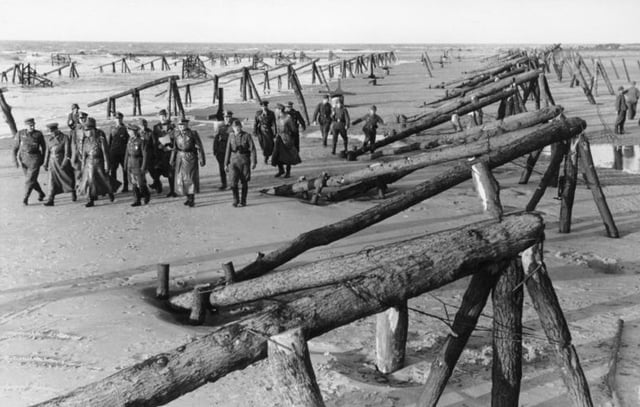
One of the many propaganda photographs of Rommel on inspection tours of the Atlantic wall
In the wake of the successful British offensive in November 1942 and other military reverses, the Propaganda Ministry directed the media to emphasize Rommel's invincibility. The charade was maintained until the spring of 1943, even as the German situation in Africa became increasingly precarious. To ensure that the inevitable defeat in Africa would not be associated with Rommel's name, Goebbels had the Supreme High Command announce in May 1943 that Rommel was on a two-month leave for health reasons.[589][23] Instead, the campaign was presented by Berndt, who resumed his role in the Propaganda Ministry, as a ruse to tie down the British Empire while Germany was turning Europe into an impenetrable fortress with Rommel at the helm of this success. After the radio program ran in May 1943, Rommel sent Berndt a case of cigars as a sign of his gratitude.[589]
Although Rommel then entered a period without a significant command, he remained a household name in Germany, synonymous with the aura of invincibility.[591] Hitler then made Rommel part of his defensive strategy for Fortress Europe (Festung Europa) by sending him to the West to inspect fortifications along the Atlantic Wall. Goebbels supported the decision, noting in his diary that Rommel was "undoubtedly the suitable man" for the task. The propaganda minister expected the move to reassure the German public and at the same time to have a negative impact on the Allied forces' morale.[592]
In France, a Wehrmacht propaganda company frequently accompanied Rommel on his inspection trips to document his work for both domestic and foreign audiences.[294][593] In May 1944 the German newsreels reported on Rommel's speech at a Wehrmacht conference, where he stated his conviction that "every single German soldier will make his contribution against the Anglo-American spirit that it deserves for its criminal and bestial air war campaign against our homeland." The speech led to an upswing in morale and sustained confidence in Rommel.[594]
When Rommel was seriously wounded on 17 July 1944, the Propaganda Ministry undertook efforts to conceal the injury so as not to undermine domestic morale. Despite those, the news leaked to the British press. To counteract the rumors of a serious injury and even death, Rommel was required to appear at the 1 August press conference. On 3 August, the German press published an official report that Rommel had been injured in a car accident. Rommel noted in his diary his dismay at this twisting of the truth, belatedly realising how much the Reich propaganda was using him for its own ends.[594]
Rommel's views on propaganda
Rommel was interested in propaganda beyond the promotion of his own image. In 1944, after visiting Rommel in France and reading his proposals on counteracting Allied propaganda, Alfred-Ingemar Berndt remarked: "He is also interested in this propaganda business and wants to develop it by all means. He has even thought and brought out practical suggestions for each program and subject."[595]
Rommel saw the propaganda and education values in his and his nation's deeds (He also did value justice itself: According to Admiral Ruge's diary, Rommel told Ruge: "Justice is the indispensable foundation of a nation. Unfortunately, the higher-ups are not clean. The slaughterings are grave sins."[596]) The key to the successful creating of an image, according to Rommel, was leading by example: "The men tend to feel no kind of contact with a commander who, they know, is sitting somewhere in headquarters. What they want is what might be termed a physical contact with him. In moments of panic, fatigue, or disorganization, or when something out of the ordinary has to be demanded from them, the personal example of the commander works wonders, especially if he has had the wit to create some sort of legend around himself."[597] He urged Axis authorities to treat the Arab with the utmost respect to prevent uprisings behind the front.[598][599]
The political scientist and historian Randall Hansen suggests that Rommel chose his whole command style for the purpose of spreading meritocracy and egalitarianism, as well as Nazi ideals he shared with Hitler due to their common non-aristocratic background.[601] His egalitarianism extended to people of other races:[602] in replying to white South African officers' demands that the black POWs should be housed in separated compounds, he refused, commenting that the black soldiers wore the same uniforms and had fought alongside the whites and thus were their equals.[603] On the other hand, Watson comments that, regarding the Afrika Korps, any Nazi indoctrination was minimised, allowing Rommel the freedom to reinvent his army in his own style.[604] Rommel's proposals were not always practical: in 1943, he surprised Hitler by proposing that a Jew should be made into a Gauleiter to prove to the world that Germany was innocent of accusations that Rommel had heard from the enemy's propaganda regarding the mistreatment of Jews. Hitler replied, "Dear Rommel, you understand nothing about my thinking at all."[47][605][606][607]
Relationship with National Socialism
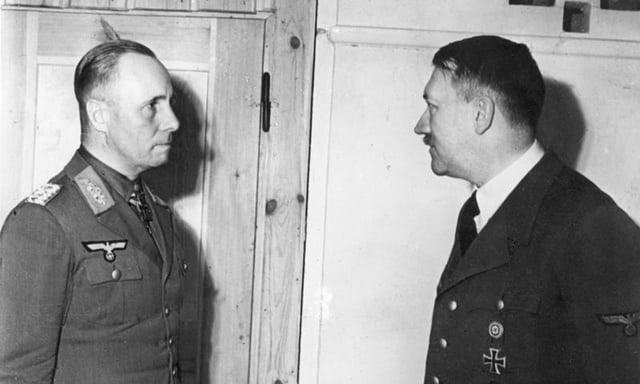
Erwin Rommel and Adolf Hitler in 1942
Rommel was not a member of the Nazi Party.[608] Rommel and Hitler had a close and genuine, if complicated, personal relationship. Rommel, as other Wehrmacht officers, welcomed the Nazi rise to power.[609][108] Numerous historians state that Rommel was one of Hitler's favorite generals and that his close relationship with the dictator benefited both his inter-war and war-time career.[110][610][108] Robert Citino describes Rommel as "not apolitical" and writes that he owed his career to Hitler, to whom Rommel's attitude was "worshipful",[578] with Messenger agreeing that Rommel owed his tank command, his hero status and other promotions to Hitler's interference and support.[578][611][24]
Kesselring described Rommel's own power over Hitler as "hypnotic".[613] In 1944, Rommel himself told Ruge and his wife that Hitler had a kind of irresistible magnetic aura ("magnetismus") and was always seemingly in an intoxicated condition.[614] Maurice Remy identifies that the point at which their relationship became a personal one was 1939, when Rommel proudly announced to his friend Kurt Hesse that he had "sort of forced Hitler to go with me (to the Hradschin Castle in Prague, in an open top car, without another bodyguard), under my personal protection ... He had entrusted himself to me and would never forget me for my excellent advice."[615]
The close relationship between Rommel and Hitler continued following the Western campaign; after Rommel sent to him a specially prepared diary on the 7th Division, he received a letter of thanks from the dictator.[616][25] (According to Speer, he would normally send extremely unclear reports which annoyed Hitler greatly.[617]) According to Maurice Remy, the relationship, which Remy calls "a dream marriage", only showed the first crack in 1942,[618] and later gradually turned into, in the words of German writer Ernst Jünger (in contact with Rommel in Normandy), "hassliebe" (a love-hate relationship).[619] Ruge's diary and Rommel's letters to his wife show his mood fluctuating wildly regarding Hitler: while he showed disgust towards the atrocities and disappointment towards the situation, he was overjoyed to welcome a visit from Hitler, only to return to depression the next day when faced with reality.[620]
Hitler displayed the same emotions. Amid growing doubts and differences, he would remain eager for Rommel's calls (they had almost daily, hour-long, highly animated conversations, with the preferred topic being technical innovations[621]): he once almost grabbed the telephone out of Linge's hand. But, according to Linge, seeing Rommel’s disobedience Hitler also realized his mistake in building up Rommel, whom not only the Afrika Korps but also the German people in general now considered the German God.[622] Hitler tried to fix the dysfunctional relationship many times without results, with Rommel calling his attempts "Sunlamp Treatment", although later he said that "Once I have loved the Führer, and I still do."[47][623] Remy and Der Spiegel remark that the statement was very much genuine, while Watson notes that Rommel believed he deserved to die for his treasonable plan.[624]
Rommel was an ambitious man who took advantage of his proximity to Hitler and willingly accepted the propaganda campaigns designed for him by Goebbels.[609][26] On one hand, he wanted personal promotion and the realization of his ideals. On the other hand, being elevated by the traditional system that gave preferential treatment to aristocratic officers would be betrayal of his aspiration "to remain a man of the troops".[27] In 1918, Rommel refused an invitation to a prestigious officer training course, and with it, the chance to be promoted to general.[626] Additionally, he had no inclination towards the political route, preferring to remain a soldier ("Nur-Soldat").[627][628][629] He was thus attracted by the Common Man theme which promised to level German society,[630] the glorification of the national community,[337] and the idea of a soldier of common background who served the Fatherland with talent and got rewarded by another common man who embodied the will of the German people.[630] While he had much indignation towards Germany's contemporary class problem, this self-association with the Common Man went along well with his desire to simulate the knights of the past, who also led from the front.[631] (The dominant parent in Rommel's life was his mother Helene, a minor "von" and a loving but ambitious and class-conscious mother who strongly stirred him towards a military career[51][632][633][634]) While Rommel was greatly attached to his profession ("the body and soul of war", a fellow officer commented),[635] he seemed to equally enjoy the idea of peace, as shown by his words to his wife in August 1939: "You can trust me, we have taken part in one World War, but as long as our generation live, there will not be a second", as well as his letter sent to her the night before the Invasion of Poland, in which he expressed (in Maurice Remy's phrase) "boundless optimism": "I still believe the atmosphere will not become more bellicose."[636] Butler remarks that Rommel was center in his politics, leaning a little to the left in his attitude.[637]
Messenger argues that Rommel's attitude towards Hitler changed only after the Allied invasion of Normandy, when Rommel came to realise that the war could not be won,[611] while Maurice Remy suggests that Rommel never truly broke away from the relationship with Hitler but praises him for "always [having] the courage to oppose him whenever his conscience required so."[618] The historian Peter Lieb states that it was not clear whether the threat of defeat was the only reason Rommel wanted to switch sides.[337] The relationship seemed to go significantly downhill after a conversation in July 1943, in which Hitler told Rommel that if they did not win the war, the Germans could rot. Rommel even began to think that it was lucky that his Afrika Korps was now safe as POWs and could escape Hitler's Wagnerian ending.[638][639][640] Die Welt comments that Hitler chose Rommel as his favourite because he was apolitical, and that the combination of his military expertise and circumstances allowed Rommel to remain clean.[641]
Rommel's political inclinations were a controversial matter even among the contemporary Nazi elites. Rommel himself, while showing support to some facets of the Nazi ideology[382] and enjoying the propaganda the Nazi machine built around him, was enraged by the Nazi media's effort to portray him as an early Party member and son of a mason, forcing them to correct this misinformation.[642][643] The Nazi elites were not comfortable with the idea of a national icon who did not wholeheartedly support the regime. Hitler and Goebbels, his main supporters, tended to defend him. When Rommel was being considered for appointment as Commander-in-Chief of the Army in the summer of 1942, Goebbels wrote in his diary that Rommel "is ideologically sound, is not just sympathetic to the National Socialists. He is a National Socialist; he is a troop leader with a gift for improvisation, personally courageous and extraordinarily inventive. These are the kinds of soldiers we need."[610] Despite this, they gradually saw that his grasp of political realities and his views could be very different from theirs.[606][644][28] Hitler knew, though, that Rommel's optimistic and combative character was indispensable for his war efforts. When Rommel lost faith in the final victory and Hitler's leadership, Hitler and Goebbels tried to find an alternative in Manstein to remedy the fighting will and "political direction" of other generals but did not succeed.[646][647]
Meanwhile, officials who did not like Rommel, such as Bormann and Schirach, whispered to each other that he was not a Nazi at all.[648] Rommel's relationship to the Nazi elites, other than Hitler and Goebbels, was mostly hostile, although even powerful people like Bormann[649] and Himmler had to tread carefully around Rommel. Himmler, who played a decisive role in Rommel's death, tried to blame Keitel and Jodl for the deed. And in fact the deed was initiated by them. They deeply resented Rommel's meteoric rise and had long feared that he would become the Commander-in-Chief.[622][650] (Hitler also played innocent by trying to erect a monument for the national hero, on 7 March 1945[651]) Franz Halder, after concocting several schemes to rein in Rommel through people like Paulus and Gause to no avail (even willing to undermine German operations and strategy in the process for the sole purpose of embarrassing him[428]), concluded that Rommel was a madman with whom no one dared to cross swords because of "his brutal methods and his backing from the highest levels." (Rommel imposed a high number of courts martial, but according to Westphal, he never signed the final order. Owen Connelly comments that he could afford easy discipline because of his charisma).[652][653][654][655] Rommel for his part was highly critical of Himmler, Halder, the High Command and particularly Goering who Rommel at one point called his "bitterest enemy".[29] Hitler realized that Rommel attracted the elites' negative emotions to himself, in the same way he generated optimism in the common people. Depending on the case, Hitler manipulated or exacerbated the situation in order to benefit himself,[429][657][30] although he originally had no intent of pushing Rommel to the point of destruction.[627] (Even when informed of Rommel's involvement in the plot, hurt and vengeful,[47] Hitler at first wanted to retire Rommel,[658] and eventually offered him a last-minute chance to explain himself and refute the claims, which Rommel apparently did not take advantage of.[659][660]) Ultimately Rommel's enemies worked together to bring him down.[429]
Maurice Remy concludes that, unwillingly and probably without ever realising it, Rommel was part of a murderous regime, although he never actually grasped the core of National Socialism.[661] Peter Lieb sees Rommel as a person who could not be put into a single drawer, although problematic by modern moral standards, and suggests people should personally decide for themselves whether Rommel should remain a role model or not.[337] He was a Nazi general in some aspects, considering his support for the leader cult (Führerkult) and the Volksgemeinschaft, but he was not an anti-Semite, nor a war criminal, nor a radical ideological fighter.[662] Historian Cornelia Hecht remarks "It is really hard to know who the man behind the myth was," noting that in numerous letters he wrote to his wife during their almost 30-year marriage, he commented little on political issues as well as his personal life as a husband and a father.[663]
Rommel myth

Rommel with Hans Speidel, who was involved in the 20 July plot
According to some revisionist authors, an assessment of Rommel's role in history has been hampered by views of Rommel that were formed, at least in part, due to political reasons, creating what these historians have called the "Rommel myth". The interpretation considered by some historians to be a myth is the depiction of the Field Marshal as an apolitical, brilliant commander and a victim of the Third Reich who participated in the 20 July plot against Adolf Hitler.[664][665] There are a notable number of authors who refer to "Rommel Myth" or "Rommel Legend" in a neutral or positive manner though.[382][663][666][31][668][669]
The seeds of the myth can be found first in Rommel's drive for success as a young officer in World War I and then in his popular 1937 book Infantry Attacks, which was written in a style that diverged from the German military literature of the time and became a bestseller.[670][139]
The myth then took shape during the opening years of World War II, as a component of Nazi propaganda to praise the Wehrmacht and instill optimism in the German public, with Rommel's willing participation. When Rommel came to North Africa, it was picked up and disseminated in the West by the British press as the Allies sought to explain their continued inability to defeat the Axis forces in North Africa.[671] The British military and political figures contributed to the heroic image of the man as Rommel resumed offensive operations in January 1942 against the British forces weakened by redeployments to the Far East. During parliamentary debate following the fall of Tobruk, Churchill described Rommel as an "extraordinary bold and clever opponent" and a "great field commander."[581][582]
According to Der Spiegel following the war's end, West Germany yearned for father figures who were needed to replace the former ones who had been unmasked as criminals. Rommel was chosen because he embodied the decent soldier, cunning yet fair-minded, and if guilty by association, not so guilty that he became unreliable, and additionally, former comrades reported that he was close to the Resistance.[47] While everyone else was disgraced, his star became brighter than ever, and he made the historically unprecedented leap over the threshold between eras: from Hitler's favourite general to the young republic's hero. Cornelia Hecht notes that despite the change of times, Rommel has become the symbol of different regimes and concepts, which is paradoxical, whoever the man he really was.[663][672] Ulrich vom Hagen reports that Rommel, for the admiration shown towards him by all sides after the war, was used as a unity symbol that led to the "elegant settlement" of the conflict between fascistic, small-bourgeois elements and the aristocratic traditionalists during the early years after the formation of the Bundeswehr.[673] Simon Ball describes how various elements in the German and British armies and governments extensively used Rommel's image in dealing with their inner struggles, promoting aspects of his that each group associated with themselves. Eric Dorman-Smith claimed that it was a "pity we could not have combined with Rommel to clean up the whole mess on both sides."[674] Already in September 1944, the officer Heinz Eugen Eberbach (later a leading figure in the Bundeswehr) anticipated that the Allied victors would have to turn to Rommel and men like him, because he was accepted by both the old regime and the working class, whom the English would not be able to win over by telling them: "The entire previous system is rotten to the core".[675]
At the same time, the Western Allies, and particularly the British, depicted Rommel as the "good German". His reputation for conducting a clean war was used in the interest of the West German rearmament and reconciliation between the former enemies—Britain and the United States on one side and the new Federal Republic of Germany on the other.[676] When Rommel's alleged involvement in the plot to kill Hitler became known after the war, his stature was enhanced in the eyes of his former adversaries. Rommel was often cited in Western sources as a patriotic German willing to stand up to Hitler. Churchill wrote about him in 1950: "[Rommel] (...) deserves our respect because, although a loyal German soldier, he came to hate Hitler and all his works and took part in the conspiracy of 1944 to rescue Germany by displacing the maniac and tyrant."[677]
Foundational works
The German rearmament of the early 1950s was highly dependent on the moral rehabilitation that the Wehrmacht needed. The journalist and historian Basil Liddell Hart, an early proponent of these two interconnected initiatives, provided the first widely available source on Rommel in his 1948 book on Hitler's generals, updated in 1951, portraying Rommel in a positive light and as someone who stood apart from the regime.[678]
The other foundational text was the influential and laudatory 1950 biography Rommel: The Desert Fox by Brigadier Desmond Young.[679][680][32] Young extensively interviewed Rommel's widow and collaborated with several individuals who had been close to Rommel, including Hans Speidel. The manner of Rommel's death had led to the assumption that he had not been a supporter of Nazism, to which Young subscribed.[676][681][33] The reception of The Desert Fox in Britain was enthusiastic, with the book going through eight editions in a year.[682] Young's biography was another step in the development of the Rommel myth – with Rommel emerging as an active, if not a leading, plotter. Speidel contributed as well, starting from the early 1950s to bring up Rommel's and his own role in the plot, boosting his [Speidel's] suitability for a future role in the new military force of the Federal Republic, the Bundeswehr, and then in NATO.[683]
Further in 1953 was the publication of Rommel's writings of the war period as The Rommel Papers, edited by Liddell Hart.[684] The book contributed to the perception of Rommel as a brilliant commander; in an introduction, Liddell Hart drew comparisons between Rommel and Lawrence of Arabia, "two masters of desert warfare."[685] Liddell Hart had a personal interest in the work: by having coaxed Rommel's widow to include material favorable to himself, he could present Rommel as his "pupil." The controversy was described by the political scientist John Mearsheimer, who concluded that, by "manipulating history", Liddell Hart was in a position to show that he was at the root of the dramatic German success in 1940.[686][687]
Elements of the myth
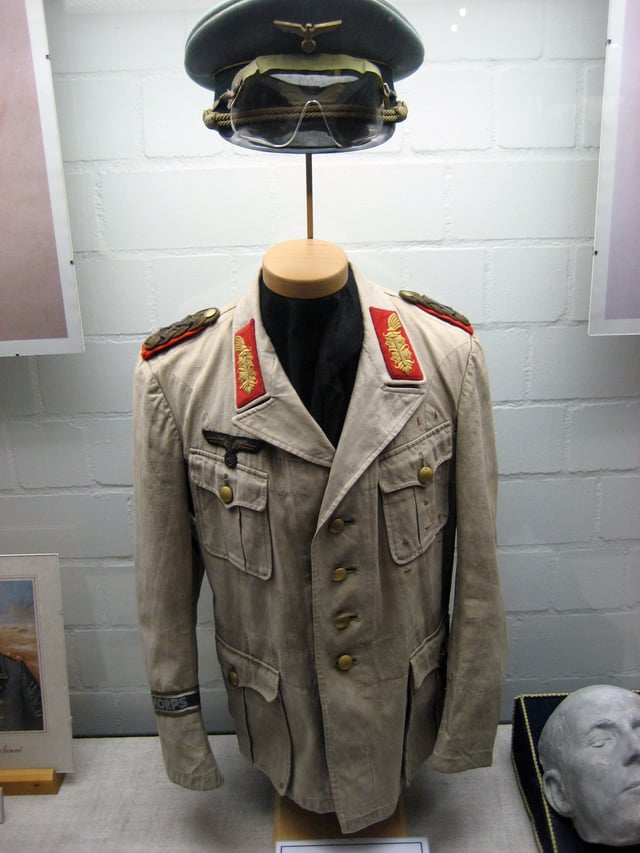
Allegedly Rommel's desert uniform and death mask (right) displayed at the German Tank Museum in Munster
According to Mark Connelly, Young and Liddell Hart laid the foundation for the Anglo-American myth, which consisted of three themes: Rommel's ambivalence towards Nazism; his military genius; and the emphasis of the chivalrous nature of the fighting in North Africa.[684] Their works lent support to the image of the "clean Wehrmacht" and were generally not questioned, since they came from British authors, rather than German revisionists.[688][34]
Historian Bruce Allen Watson offers his interpretation of the myth, encompassing the foundation laid down by the Nazi propaganda machine. According to Watson, the most dominant element is Rommel the Superior Soldier; the second being Rommel the Common Man; and the last one Rommel the Martyr.[689] The German news magazine Der Spiegel described the myth in 2007 as "Gentleman warrior, military genius."[690][35]
Contradictions and ambiguities
During recent years, historians' opinions on Rommel have become more diversified, with some aspects of his image being the target of revisionism more frequently than the others. According to the prominent German historian Hans-Ulrich Wehler, the modern consensus agrees with post-war sources that Rommel treated the Allied captives decently, and he personally thinks that the movie Rommel does not overstate his conscience. Also according to Wehler, scholars in England and the US still show a lot of admiration towards Rommel the military commander.[605] Some authors, notably Wolfgang Proske, see Rommel as a criminal whose memorials should be removed, although these represent the unorthodox minority (which is admitted by Proske).[691][692] Perry and Massari note that the majority of historians continue to describe Rommel as a brilliant, chivalrous commander.[538][693]
Modern historians who agree with the image of the apolitical, chivalrous genius[694][695][696][693][697][698][699][700] also have different opinions regarding details. Smith and Bierman opine that Rommel might be considered an honourable man in his limited way but in a deeply dishonourable cause, and that he played the game of war with no more hatred for his opponent than a rugby team captain might feel for his opposite number.[701] Butler states that Rommel's idealistic character led to grave misjudgements because he refused to let anything compromise it, and also that although he had a sense of strategy that developed greatly during the war, he lacked a philosophy of war.[702]
According to some modern scholars, he was much more complex than the figure that has been firmly established in post-war reputation.[703] Caddick-Adams writes that Rommel was a "complicated man of many contradictions,"[704] while Beckett notes that "Rommel's myth (...) has proved remarkably resilient" and that more work is needed to put him in proper historical context.[324] Watson opines that historians often portray Rommel as someone they want him to be, "coward ... hero, fool, villain or hypocrite," and that he seemed to be all of these things, except coward, with perhaps a naive loyalty.[705] Hansen counters that Rommel was hardly naive, always judged military and political situations with cold objectivity, and shared a lot of characteristics with Hitler,[706] an opinion shared by psychoanalyst and historian Geoffrey Cocks who writes that Rommel "embodies the modern synergy of technical expertise and self-promotion ... arriviste, ... professionally ambitious, adept at cultivating a mass media image ... like Hitler."[707]
There is also, especially in Germany, an increasing tendency to portray Rommel as someone who cannot be explained in concrete details yet. However, these modern authors, while respecting the man and his mythical aura, are not afraid to show his questionable traits or point out the horrible (including the possible) consequences of his "politically extremely naive" actions that perhaps would not be fitting of a role model, and allow living witnesses who might portray Rommel in a negative light to speak in documentaries about him, to the extent some, like General Storbeck, consider excessive and unbalanced (Storbeck states that there are many other witnesses who will provide the opposite views, and also questions the use of an extremely ill Manfred Rommel to achieve a portrayal filmmakers want).[441][708][709][666][710]
Reputation as military commander

Rommel and Vice Admiral Friedrich Ruge visiting the U-boat base in La Rochelle, France, February 1944
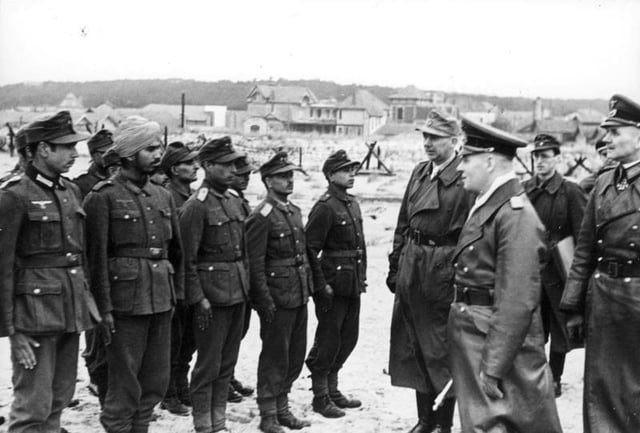
Inspecting the soldiers of the anti-British Free India Legion, France, 1944
Rommel had been extraordinarily well known in his lifetime, including by his adversaries. His tactical prowess and consistent decency in the treatment of Allied prisoners earned him the respect of many opponents, including Claude Auchinleck, Archibald Wavell, George S. Patton, and Bernard Montgomery.[711]
Rommel's military reputation has been controversial. While nearly all military practitioners acknowledge Rommel's excellent tactical skills and personal bravery, some, such as U.S. major general and military historian David T. Zabecki of the United States Naval Institute, considers Rommel's performance as an operational level commander to be highly overrated. He argues that other officers share this belief.[110][36] General Klaus Naumann, who served as Chief of Staff of the Bundeswehr, agrees with the military historian Charles Messenger that Rommel had challenges at the operational level, and states that Rommel's violation of the unity of command principle, bypassing the chain of command in Africa, was unacceptable and contributed to the eventual operational and strategic failure in North Africa.[712][37] The German biographer Wolf Heckmann describes Rommel as "the most overrated commander of an army in world history".[713]
Nevertheless, there is also a notable number of officers who admire his methods, like Norman Schwarzkopf who describes Rommel as a "genius at battles of movement" and explains that "Look at Rommel. Look at North Africa, the Arab-Israeli wars, and all the rest of them. A war in the desert is a war of mobility and lethality. It's not a war where straight lines are drawn in the sand and [you] say, 'I will defend here or die."[714][715] Ariel Sharon deemed the German military model used by Rommel to be superior to the British model used by Montgomery.[716] His compatriot Moshe Dayan likewise considered Rommel a model and icon.[717] Wesley Clark states that "Rommel's military reputation, though, has lived on, and still sets the standard for a style of daring, charismatic leadership to which most officers aspire."[718] During the recent desert wars, Rommel's military theories and experiences attracted great interest from policy makers and military instructors.[719][720] Chinese military leader Sun Li-jen had the laudatory nickname "Rommel of the East".[721] The Bundeswehr and Germany's NATO partners recognize Rommel as the modern knight of the Bundeswehr, a highly successful operator of military arts and an apolitical, chivalrous soldier (with several leaders of the Bundeswehr like Helmut Willmann, Hartmut Bagger and Edgar Trost declaring him as their personal role model). This ideal of modern knighthood is connected and combined with the anachronistic Miles Christianus model, the more recent "Miles Protector" model,[722] the "Soldier-Statesman" concept, and the traditional monofunctional combatant.[723]
Certain modern military historians, such as Larry T. Addington, Niall Barr, Douglas Porch and Robert Citino, are skeptical of Rommel as an operational, let alone strategic level commander. They point to Rommel's lack of appreciation for Germany's strategic situation, his misunderstanding of the relative importance of his theatre to the German High Command, his poor grasp of logistical realities, and, according to the historian Ian Beckett, his "penchant for glory hunting".[703][578] Citino credits Rommel's limitations as an operational level commander as "materially contributing" to the eventual demise of the Axis forces in North Africa,[578][38] while Addington focuses on the struggle over strategy, whereby Rommel's initial brilliant success resulted in "catastrophic effects" for Germany in North Africa.[724] Porch highlights Rommel's "offensive mentality", symptomatic of the Wehrmacht commanders as a whole in the belief that the tactical and operational victories would lead to strategic success. Compounding the problem was the Wehrmacht's institutional tendency to discount logistics, industrial output and their opponents' capacity to learn from past mistakes.[725]
The historian Geoffrey P. Megargee points out Rommel's playing the German and Italian command structures against each other to his advantage. Rommel used the confused structure (the OKW (Supreme Command of the Wehrmacht), the OKH (Supreme High Command of the Army) and the Italian Supreme Command) to disregard orders that he disagreed with or to appeal to whatever authority he felt would be most sympathetic to his requests.[726]
Some historians take issue with Rommel's absence from Normandy on the day of the Allied invasion, 6 June 1944. He had left France on 5 June and was at home on the 6th celebrating his wife's birthday. (According to Rommel, he planned to proceed to see Hitler the next day to discuss the situation in Normandy).[727][728] Zabecki calls his decision to leave the theatre in view of an imminent invasion "an incredible lapse of command responsibility".[727] Lieb remarks that Rommel displayed real mental agility, but the lack of an energetic commander, together with other problems, caused the battle largely not to be conducted in his concept (which is the opposite of the German doctrine), although the result was still better than Geyr's plan.[729] Lieb also opines that while his harshest critics (who mostly came from the General Staff) often said that Rommel was overrated or not suitable for higher commands, envy was a big factor here.[730]
T.L. McMahon argues that Rommel no doubt possessed operational vision, however Rommel did not have the strategic resources to effect his operational choices while his forces provided the tactical ability to accomplish his goals, and the German staff and system of staff command were designed for commanders who led from the front, and in some cases he might have chosen the same options as Montgomery (a reputedly strategy-oriented commander) had he been put in the same conditions.[731] According to Steven Zaloga, tactical flexibility was a great advantage of the German system, but in the final years of the war, Hitler and his cronies like Himmler and Goering had usurped more and more authority at the strategic level, leaving professionals like Rommel increasing constraints on their actions.[732] Martin Blumenson considers Rommel a general with a compelling view of strategy and logistics, which was demonstrated through his many arguments with his superiors over such matters, although Blumenson also thinks that what distinguished Rommel was his boldness, his intuitive feel for the battlefield.[504](Upon which Schwarzkopf also comments "Rommel had a feel for the battlefield like no other man."[733])
Joseph Forbes comments that: "The complex, conflict-filled interaction between Rommel and his superiors over logistics, objectives and priorities should not be used to detract from Rommel's reputation as a remarkable military leader", because Rommel was not given powers over logistics, and because if only generals who attain strategic-policy goals are great generals, such highly regarded commanders as Robert E. Lee, Hannibal, Charles XII would have to be excluded from that list.[734] General Siegfried F. Storbeck, Deputy Inspector General of the Bundeswehr (1987–1991), remarks that, Rommel's leadership style and offensive thinking, although carrying inherent risks like losing the overview of the situation and creating overlapping of authority, have been proved effective, and have been analysed and incorporated in the training of officers by "us, our Western allies, the Warsaw Pact, and even the Israel Defense Forces."[441] Maurice Remy and Samuel W. Mitcham both defend his strategic decision regarding Malta as, although risky, the only logical choice.[39][40] Mitcham also takes note of the fact that the British C-in-C actually feared that the German leadership would embark on Rommel's strategic plans regarding the Suez Canal instead of that of Hitler.[737]
Rommel was among the few Axis commanders (the others being Isoroku Yamamoto and Reinhard Heydrich) who were targeted for assassination by Allied planners. Two attempts were made, the first being Operation Flipper in North Africa in 1941, and the second being Operation Gaff in Normandy in 1944.[738]
Family life

Bust of Rommel at Al Alamein war museum in Egypt, which was built by Anwar Sadat in honour of Rommel. The museum was later expanded into a general war museum but Rommel remains a central figure.[744]
While at Cadet School in 1911, Rommel met and became engaged to 17-year-old Lucia (Lucie) Maria Mollin (1894–1971).[62] While stationed in Weingarten in 1913, Rommel developed a relationship with Walburga Stemmer, which produced a daughter, Gertrude, born 8 December 1913.[739] Because of elitism in the officer corps, Stemmer's working-class background made her unsuitable as an officer's wife, and Rommel felt honour-bound to uphold his previous commitment to Mollin. With Mollin's cooperation, he accepted financial responsibility for the child.[740] Rommel and Mollin were married in November 1916 in Danzig.[62] Rommel's marriage was a happy one, and he wrote his wife at least one letter every day while he was in the field.[62]
After the end of the First World War, the couple settled initially in Stuttgart, and Stemmer and her child lived with them. Gertrude was referred to as Rommel's niece, a fiction that went unquestioned due to the enormous number of women widowed during the war.[741] Walburga died suddenly in October 1928, and Gertrude remained a member of the household until Rommel's death in 1944.[742] A son, Manfred Rommel, was born on 24 December 1928, later served as Mayor of Stuttgart from 1974 to 1996.[743]
Awards
Military Merit Order (Württemberg)[745]
Iron Cross 2nd Class on 24 September 1914 and 1st Class on 29 January 1915[746]
Pour le Mérite on 18 December 1917[747]
Clasp to the Iron Cross 2nd Class on 13 May 1940 and 1st Class on 15 May 1940[748]
Knight's Cross of the Iron Cross with Oak Leaves, Swords and Diamonds Knight's Cross of the Iron Cross on 27 May 1940 as commander of the 7th Panzer-Division[749] Oak Leaves (10th recipient) on 20 March 1941 as commander of the 7th Panzer-Division[749] Swords (sixth recipient) on 20 January 1942 as commander of the Panzer Group Afrika[749] Diamonds (sixth recipient) on 11 March 1943 as commander in chief of the Army Group Afrika[749]
Italian Gold Medal of Military Valour in February 1942[750]
Knight of the Colonial Order of the Star of Italy in February 1942[750]
Posthumous honours

Memorial to Erwin Rommel in Heidenheim, Germany
The German Army's largest base, the Field Marshal Rommel Barracks, Augustdorf, is named in his honour; at the dedication in 1961 his widow Lucie and son Manfred Rommel were guests of honour.[751] The Rommel Barracks, Dornstadt, was also named for him in 1965.[751] A third base named for him, the Field Marshal Rommel Barracks, Osterode, closed in 2004. A German Navy Lütjens-class destroyer, Rommel, was named for him in 1969 and christened by his widow; the ship was decommissioned in 1998.[752]
Numerous streets in Germany, especially in Rommel's home state of Baden-Württemberg, are named in his honor, including the street near where his last home was located. The Rommel Memorial was erected in Heidenheim in 1961. The Rommel Museum opened in 1989 in the Villa Lindenhof in Herrlingen;[753] there is also a Rommel Museum in Mersa Matruh in Egypt which opened in 1977, and which is located in one of Rommel's former headquarters; various other localities and establishments in Mersa Matruh, including Rommel Beach, are also named for Rommel.[754] The reason for the naming is that he respected the Bedouins' traditions and the sanctity of their homes (he always kept his troops at least 2 kilometers from their houses) and refused to poison the wells against the Allies, fearing doing so would harm the population.[755]
In Italy, the annual marathon tour "Rommel Trail", which is sponsored by the Protezione Civile and the autonomous region of Friuli Venezia Giulia through its tourism agency, celebrates Rommel and the Battle of Caporetto. The naming and sponsoring (at that time by the center-left PD) was criticized by the politician Giuseppe Civati in 2017.[756][757]
